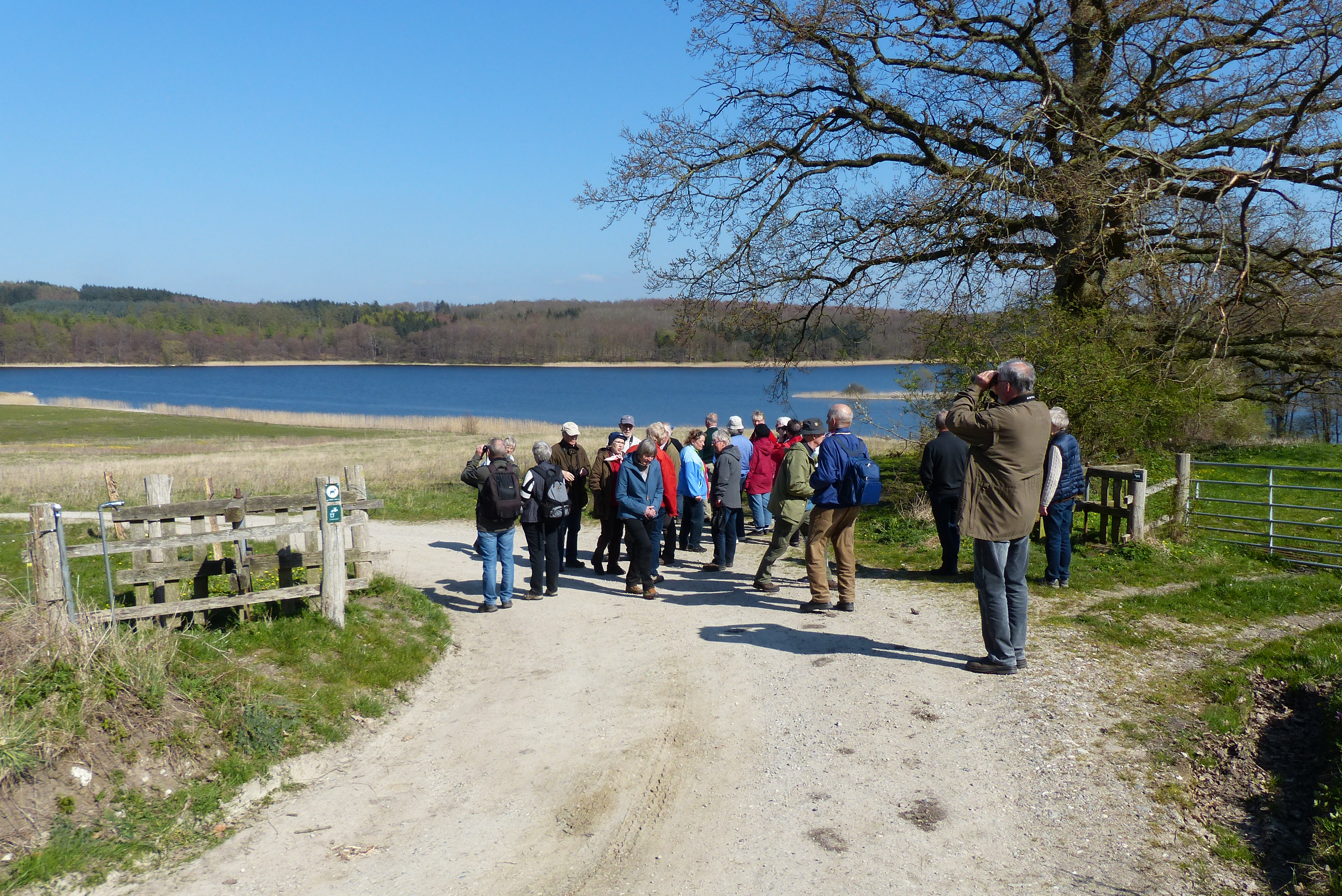1) Alsønderup Enge
2) Avnø
3) Bagsværd Sø
4) Borreby Mose
5) Enø Overdrev
6) Fladstrand
7) Gentofte Sø and Brobæk Mose
8) Gilleleje
9) Gribskov
10) Gundsømaglesø
11) Hellebæk
12) Holmegaards Mose and surroundings
13) Jægerspris Nordskov
14) Kagsmosen
15) Nivå Bugt coastal meadows
16) Præstesø
17) Præstø Fjord and Feddet
18) Ravnstrup Sø
19) Rørvig Peninsula
20) Selsø Sø
21) Smør- and Fedtmosen
22) Stevns Klint
23) Stigsnæs
24) Store Hareskov
25) Sømosen
26) Tissø
27) Tisvilde Hegn and Melby Overdrev
28) Tystrup Bavelse Lakes
29) Utterslev Mose
30) Vaserne
31) Vestamager
32) Ølsemagle Revle
Alsønderup Enge
North Zealand, east of the lake of Arresø
Wetland of great importance for waterbirds and raptors – not least osprey and white-tailed eagle.
See Google map with bird observation tower, car park, etc.

Description:
Alsønderup Enge is two kilometers east of the lake of Arresø. The original wet meadows were drained in the 1930s to be used for peat digging, and were afterwards used for grazing. However, the Nature Agency had them flooded again in 1987 to create a bird reserve. There was no access for the public, but a bird observation tower was erected to give visitors a good view over the area. The project was a great success and several uncommon breeding birds turned up. At the end of the 1990s a new project was carried out to divert the Pøleå stream through the lake, but this has resulted in an increase in the nutrient content of the lake and a deterioration of the water quality, with a reduction in the number of breeding birds as a consequence.
Birds:
Breeding birds:
Several pairs of great crested grebe nest at the lake, together with mute swan, greylag goose, shelduck, mallard, goldeneye and tufted duck. Lapwings breed on the wet meadows and reed warbler, marsh warbler and reed bunting nest in the thickets next to the lake. Marsh harrier has bred at the northern end of the lake for the last few years.
A pair of white-tailed eagles has nested in Nejede Vesterskov since 2009. Many other raptors also breed here. Nejede Vesterskov has been designated as undisturbed woodland, which has had an influence on the hole-nesting bird species. There is a large population of species such as stock dove, great spotted woodpecker and nuthatch. Lesser spotted woodpecker has been observed several times in the area around the observation tower.
A wide range of common woodland birds breed here too.
Migrating and staging birds:
White-tailed eagle can be seen all year round. The birds catch bream in the lake here or in the lake of Arresø, and can often be seen sitting in a tree next to the lake. Osprey is a regular visitor and also catches fish in the lake. It is seen both spring and summer. Other raptors spotted here include red kite, hen harrier (in winter), buzzard and goshawk.
The lake attracts many species of duck, including shelduck, wigeon, gadwall, teal, mallard and tufted duck. In winter smew and goosander are seen. Other birds seen here include grey heron, mute swan, greylag goose (often in flocks of several hundred birds) and the commonest species of gull. Great white egret can be in the area several times a year. Apart from lapwing, waders turn up only sporadically and in small numbers. With luck, one can spot a kingfisher. Raven is seen throughout the year, both on the meadows and over the woodland.
Visiting and access:
The area is best seen from the observation tower south of the lake. One can get to this from route 16 which leads south of Arresø from Frederiksværk. About 1km east of Meløse one can turn off onto the Marguerite Trail, which leads east around the lake of Arresø. In Nejede, one continues in the direction of Alsønderup, on a road called Ravnsbjergvej. There is a car-park in the wood. Look out for a little sign “Fugletårn” (bird tower) which can be difficult to spot. From the car-park a trail leads through the wood of Nejede Vesterskov. After around 100m another trail leads off to the right. After about 1km one reaches the edge of the wood, and around 20m to the left is a path leading to the lake and the tower. There is no admittance to the bird reserve itself.
The Nature Agency recommends avoiding the central part of Nejede Vesterskov due to the breeding white-tailed eagles.

Goosander. Photo: Helge Sørensen
Avnø
South-east Zealand
A natural habitat on a former airforce base, with breeding and staging swans, geese, ducks and waders.
See Google map for car parks, bird observation towers, etc.
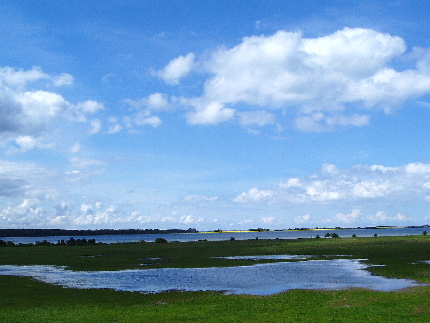 Avnø - view from the tower towards the west. Photo: Finn Jensen
Avnø - view from the tower towards the west. Photo: Finn Jensen
Description:
Avnø was formerly an airforce base, but the airforce pulled out in 1993 and the area was protected in 2002. The area consists of coastal meadows, marshes, copses and the coast with many stones and boulders.
The area is managed by the Danish Nature Agency. A good deal of nature restoration has been carried out: for example three large ponds and several smaller ponds have been established. Several of the drains have been put out of action, which means that much of the area is covered with water. The depth of the water in the ponds varies throughout the year and they can sometimes dry out. Several heaps of stones have been placed around the area for the benefit of frogs and reptiles. The area is grazed by cattle. In 2011 a bird island called Klydeøen (Avocet Island) was established. Since then, a deeper channel has been dug out around the island and at high tide the water is connected to the lagune. Just north of Avnø are the bay of Svinø Vig and the meadows of Hylteholme, where many birds can be seen.
To the west of Avnø, in Avnø Fjord, is Avnø Røn, which is an uninhabited island with large boulders and a long sandy beach that is flooded at high tide.
Birds:
Breeding birds:
There are a heronry and a rookery in the wood. The coastal meadows and the coast are home to a limited number of breeding mute swan, greylag goose, shelduck, teal, mallard, shoveler, garganey, oystercatcher, lapwing and redshank. There is a colony of cormorants on Avnø Røn, where they build their nests on the ground. There are no longer any breeding birds on the bird island, as the vegetation has grown too high for waders.
Migrating and staging birds:
Many mute swans and greylag geese use the area throughout the year. In the past few years large numbers of barnacle geese have appeared. They use the area as a staging post and especially as a night roost. In summer many species of duck can be spotted, including gadwall, teal, mallard, garganey and shoveler, with wigeon turning up in autumn.
Apart from the wader species that breed here, large flocks of golden plover can be seen together with smaller flocks of grey plover, knot, curlew sandpiper and wood sandpiper. Curlew forage here all year round.
Whooper swan, white-fronted goose, canada goose, goosander and coot overwinter here. They can often be seen out at sea just off the peninsula. In winter, the open areas attract large flocks of twite. Hen harrier is a regular winter visitor. Short-eared owl can be seen over the meadows in winter.
White-tailed eagles are seen all year round, both adults and young. The birds often sit on Avnø Røn or on one of the large boulders in the water, or fly in over Avnø or Knudskov. Peregrine are seen autumn, winter and spring, and occasionally in summer.
Rare birds can be spotted occasionally: for example, a sandhill crane in 2021, broad-billed sandpiper in 2018 and 2023, and red-breasted goose, which has been spotted in 2019, 2020 and 2023 - occasionally with up to 5 individuals at the same time.
Other animals:
Common seal breeds on Avnø Røn. The animals can often be seen sunbathing on the many boulders off the peninsula of Avnø.
Visiting and access:
Avnø can be reached from route 22 between Næstved and Vordingborg. Coming from the north, turn right in the direction of Svinø shortly after passing Dybsø Fjord. Turn left after the church in Svinø and after around 3km turn right along Flyvervej in the direction of Avnø. Coming from the south on route 22, turn left at Sallerup and shortly afterwards left again, and then follow the road to Avnø.
There is a car park at the nature centre which has been installed in the old air station, and which has an exhibition about Avnø. There is free admission throughout the year during the daytime. There are also toilets and picnic facilities at the centre. There is also access to the former control tower, from where there is a good view over the whole area. This is the best place from which to view the small ponds on the meadow.
There are several marked trails around the area. In the birds’ breeding season (15th March – 15th July) it is only permitted to walk along the red, blue and yellow trails. There is a bird observation tower at the wood of Nokkeskov in the eastern section of the Avnø peninsula (blue trail). Here there are also a tent site, a bonfire site, a grill, and four new shelters (booking required). A newly renovated bird hide in the north-west section (red trail) looks across to Hylteholme with its lagoons and channels.
The island of Avnø Røn is best seen from the coast of Avnø or from the control tower. There is no access to the island all year round. There is also limited access to the part of the fjord surrounding the island.

Mute swans. Photo: Jens Peter Lomholt
Bagsværd Sø
North-west of Copenhagen between Furesø and Kongens Lyngby
Birdlife all year round in a lake used for boat races
See Google-map
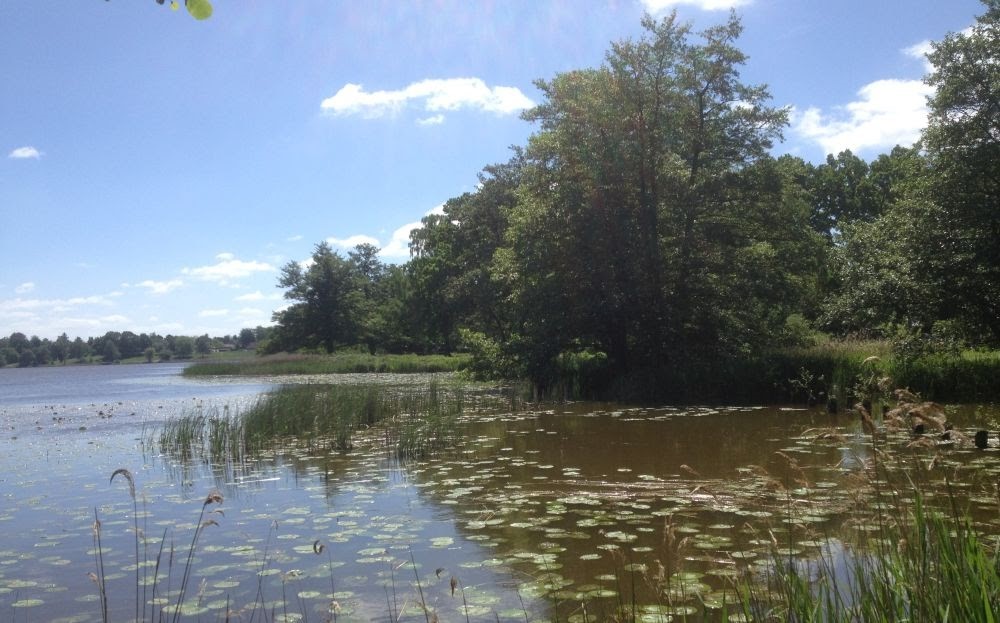
Bagsværd Sø. Photo: Frank Desting
Description:
Bagsværd Sø is part of the Mølleå system comprising a series of lakes and the Mølleå stream itself, stretching from its source near Roskilde Fjord to where it runs into the Øresund. The trench in which the system lies was formed during the last Ice Age by melting water running under the ice. Bagsværd Sø is in the southern part of this system and is the second largest lake, with an area of around 116 ha and a maximum depth of 3.5 m. It has been used as a millpond in the past.
The lake is now popular for excursions and offers sailing and fishing activities. Since the 1930’s, it has been used for international rowing competitions.
The nature in and around Bagsværd Sø is varied and interesting. In the middle of the lake is the little island of Gåseholm.
Birds:
Breeding birds:
Breeding birds include great crested grebe, grey heron (there is a heronry in the alder trees at Radiomarken), mute swan, greylag goose, goldeneye, goshawk (in Frederiksdal Skov), buzzard, kestrel (at Radiomarken), tawny owl, cuckoo, great spotted woodpecker, fieldfare (colony at Aldershvile Slotspark), and many different passerines, including warblers, tits, short-toed treecreeper, raven and starling.
Migrating and staging birds:
In the summer, common tern and sometimes sandwich tern can be seen foraging over the lake. Caspian tern has also been spotted more and more frequently the last few years.
In spring and autumn a great many migrating birds can be observed over the lake. Mute swan, greylag goose and barnacle goose are seen regularly. Raptors include honey buzzard, red kite, many buzzards, rough-legged buzzard, white-tailed eagle, osprey, marsh harrier, hen harrier, hobby and merlin. Flocks of cranes pass over in easterly winds.
In the winter months, goldeneye, goosander, goshawk and raven often visit the area. Now and then flocks of redpolls, waxwings and hawfinches turn up. There is a good chance of seeing a kingfisher. It can be spotted at various locations around the lake, but especially behind Aldershvile Planteskole (nursery).
Sporadic guests such as black woodpecker and little woodpecker have also been observed at Bagsværd Sø several times. The rare great reed warbler has also visited the area, with up to two singing birds in the spring/summer of 2000 and 2011 respectively.
Visiting and access:
The nearest S-train station is Bagsværd Station. If you come by car, there are several places you can park around the lake. It is possible to walk or cycle the whole way around the lake. Places of special natural interest are Aldershvile Slotspark, Radiomarken and Sophienholm.
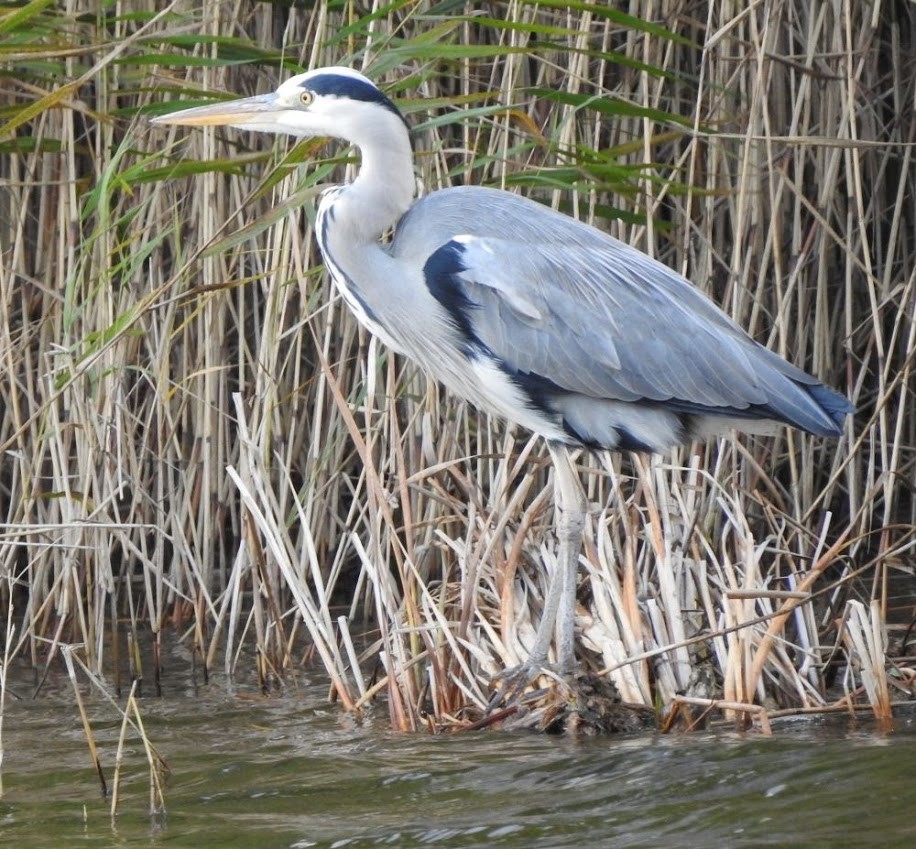
Grey heron, Bagsværd Sø. Photo: Frank Desting
Borreby Mose
South-west Zealand, south of Skælskør
One of Zealand’s best localities for waterbirds.
See Google map with car parks etc.

Borreby Mose. Photo: Joy Klein
Description:
Borreby Mose is a large area with bog and reedbeds. Around the bog are extensive meadows used for grazing.
Birds:
Breeding birds:
Several waterbirds breed at Borreby Mose, including red-necked grebe, greylag goose, shelduck, gadwall, teal, mallard, pochard and tufted duck. The bog is especially interesting as it is a breeding locality for black-tailed godwit. Other breeding waders include avocet, ringed plover, lapwing and redshank. Various warblers such as sedge warbler, marsh warbler and reed warbler are heard in the reedbeds, and bearded tit breeds here. Now and again less common species such as great reed warbler and Savi’s warbler appear.
Marsh harrier is seen throughout the summer months and breeds in the bog and in the reedbeds. Bittern is heard every year but it is not known if it breeds here. There is a colony of grey herons at Borreby estate that has grown appreciably during the last few years.
Migrating and staging birds:
Borreby Mose is an important staging area for geese, especially in autumn. Greylag geese are predominant and sometimes turn up in flocks of several thousand birds, but Canada geese, barnacle geese and a few white-fronted geese are also seen here. Various dabbling ducks and diving ducks visit the locality. Pintail visits the area in spring. Gadwall, teal and shoveler can be observed nearly all year round. In winter, wigeon, pochard and tufted duck are seen – the latter often in thousands. Smew and goosander are also winter guests.
Little tern fly over the bog in the summer months.
In autumn, migrating waders turn up on their way south. Lapwings can appear in flocks of several hundreds, and in addition there are smaller numbers of ringed plover, golden plover, dunlin, ruff, black-tailed godwit and wood sandpiper. Snipe is also a frequent autumn visitor.
White-tailed eagle often frequent the area as a pair have started nesting in the vicinity. Several other species of raptor can be seen hunting in the area at regular intervals, including red kite, osprey and peregrine. In winter, hen harrier and rough-legged buzzard can be spotted. Kingfisher is seen all year round and may possibly breed here.
A few less common birds turn up at intervals, for example the last few years have brought pectoral sandpiper, red-necked phalarope and caspian tern. Great white egret has started to show up regularly and is now seen nearly every year. The last few years, several individuals have been spotted together.
Visiting and access:
From Skælskør, drive south along a minor road towards Borreby/Fornetofte. Just past the road leading to the Borreby estate is a car park. From here, a path leads along the reedbeds and out to the dyke, with views across Skælskør Fjord. This area attracts many birds, including cormorants, swans, eiders and mergansers. On the way out to the dyke one can often be lucky enough to see bearded tits in the reedbeds.
About 500m further along the road, there are car parks on either side of the road. From here there are excellent views across the locality. The birds can be easily seen with binoculars.
The Borreby estate just north of Borreby Mose boasts one of Denmark’s oldest and best preserved renaissance castles and has an attractive park. There is public access to some of the park, which supports many warblers, including flycatchers. Short-toed treecreepers nest in the trees along the avenue.
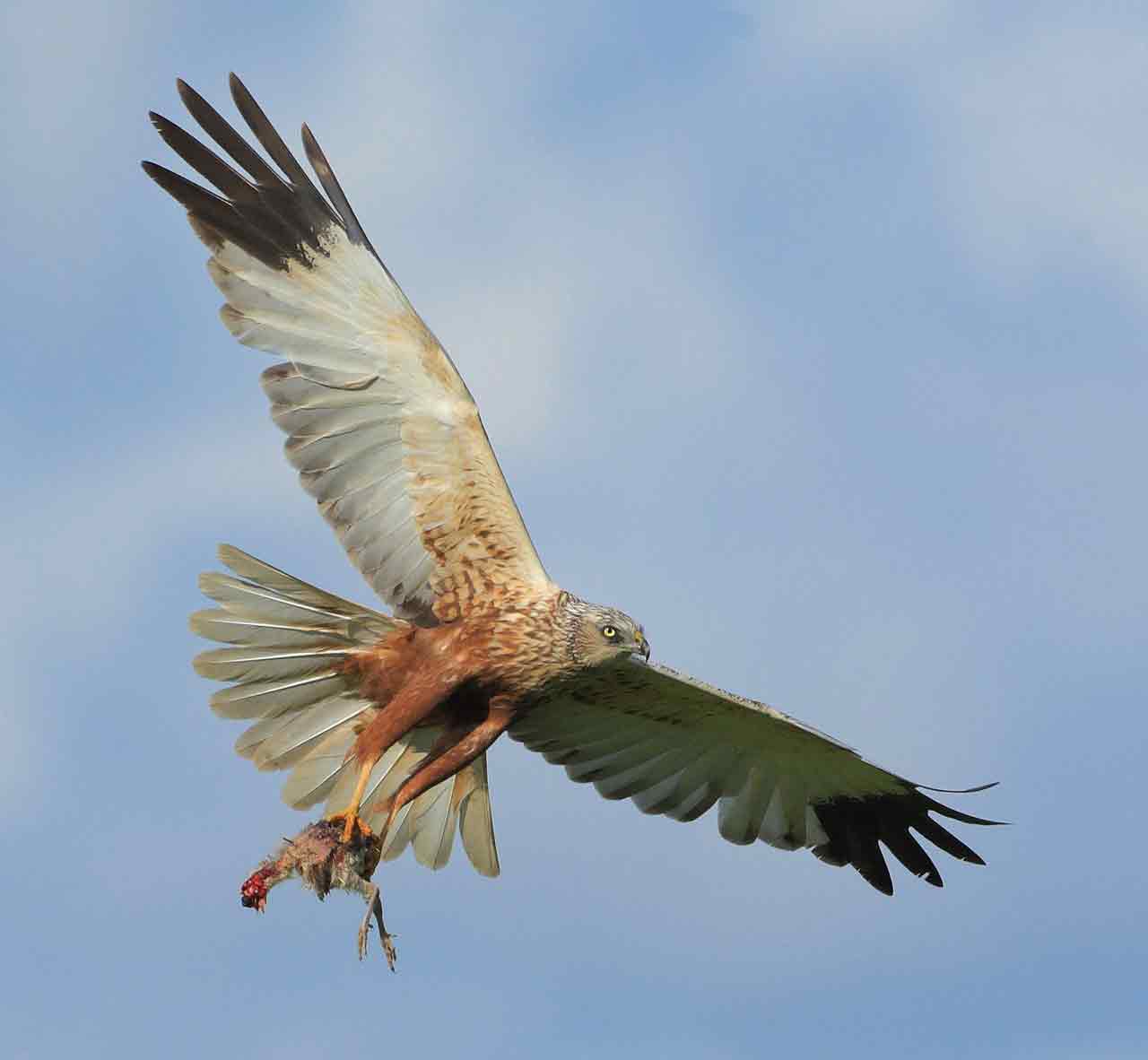
Marsh harrier with prey. Photo: Axel Mortensen
Enø Overdrev
South-west Zealand
A grassy peninsula with many breeding and staging waterbirds and waders
See Google-map with car-park etc.
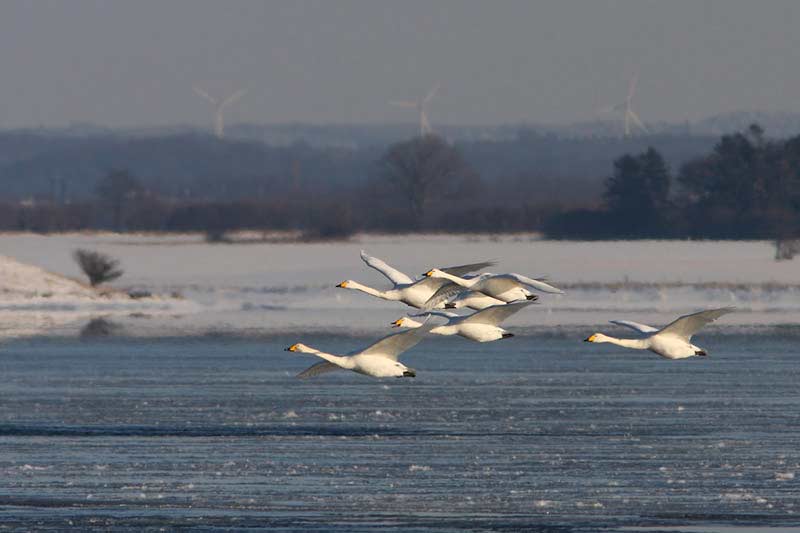
Whooper swans at Enø Ovedrev. Photo: Steen E. Jensen
Description:
The island of Enø, south of the town of Næstved, is a double island around 5km long and up to 11m high. It consists of two glacial deposits connected by a bar. The village of Enø is on the northern part. The southern part consists of grazed coastal meadows with some wet areas, small islets and recurved spits, and grasslands with hawthorn thicket. The thicket can house many passerines during migration.
Birds:
Breeding birds:
Since the start of the 1990’s, the number of breeding birds has declined due to predation by fox and to human disturbance. However, there is still part of the area where access is forbidden during the birds’ breeding season, and this is where most of them nest. Breeding birds include mute swan, shelduck, mallard, oystercatcher, ringed plover, lapwing and redshank. There are also some small colonies of common gull and arctic tern. Little tern can be seen now and again in summer, but no longer breeds here. Nesting passerines include skylark, yellow wagtail and icterine warbler. There is a large colony of sand martins just north-west of the grasslands and the martins can be seen flying around over the area all the summer.
Migrating and staging birds:
Outside the breeding season, many ducks and waders can be spotted in the area. Ducks include wigeon, teal, mallard, pintail, tufted duck, goldeneye, red-breasted merganser and goosander. Large flocks of mute swan can be seen. Geese include greylay geese and often large flocks of barnacle geese in the migration season, together with canada geese which are seen from time to time. Coot can assemble in large flocks.
Many different waders use the area to stage and forage. Golden plover, lapwing and dunlin form the largest flocks, but one can also spot ringed plover, grey plover, knot, little stint, curlew sandpiper, bar-tailed godwit, curlew, spotted redshank and redshank. Heron and cormorant are seen throughout the year.
White-tailed eagles – sometimes several individuals at a time – are often seen over the area, and peregrine falcon has become a permanent guest. One can sometimes be seen perching on a tuft of grass in the middle of the grassland, or on a mound on the beach. In winter, hen harrier is observed. Kestrel often hunts over the grassland.
In winter, whooper swans and geese can be seen together with flocks of twite and snow bunting and - more rarely - shore lark.
If the shallow waters around Enø freeze over in winter, large flocks of birds can be seen in the canal and the adjacent areas, which are always free of ice.
Visiting and access:
From Næstved, drive along Karrebækvej to Karrebæksminde. Drive over the bridge and continue to a roundabout in the village of Enø. From here, follow Enø Kystvej to a large car-park. Walk along the gravel track to a gate opening onto the grassland area - a walk of just over a kilometre. To the right of this gate is a smaller gate giving easy access to the grassland. An alternative route is to walk through the area that was formerly used as a holiday camp, which is situated just before the entrance to the grassland. The whole site, including the buildings, is owned by Næstved municipality and there is free entrance and places to sit. Go past the buildings and out to the sea, where there are steps leading down to the beach. From here, one can walk eastwards along the beach. Halfway to the end of the grassland is another little gate, which also opens onto the grassland.
At the easternmost point of the island there is a view across to the island of Dybsø, where extensive mudflats appear at low tide.
In the birds’ breeding season (1/4 – 15/7) there is no access to parts of the grassland. These areas are marked by posts. In addition, horses, cattle and sheep are let loose on the grassland from around Easter to the middle of October, so please avoid disturbing them.
The area is privately owned. Enø Overdrev was put under preservation orders in 1953 to preserve the beautiful and unspoilt landscape.
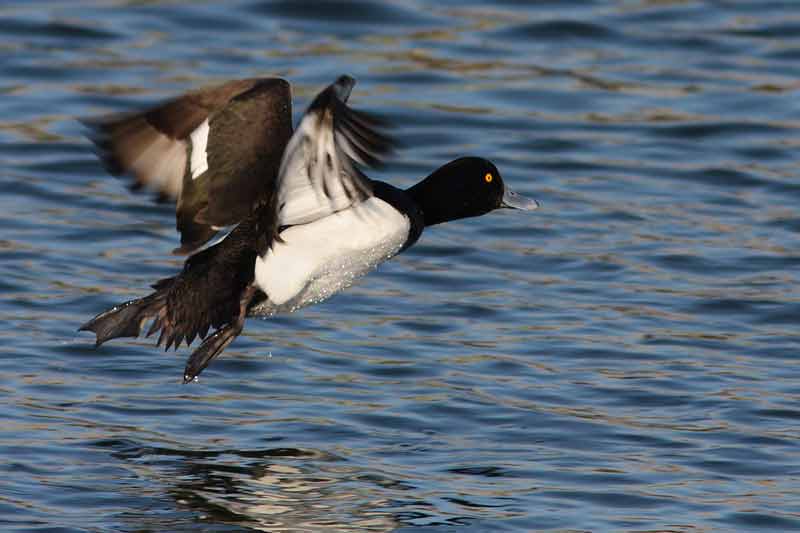
Tufted duck. Photo: Steen E. Jensen
Fladstrand
South Zealand, immediately south of Næstved
Important locality for staging ducks. Large flocks of birds in winter when lakes are frozen. White-tailed eagle breeds in the vicinity.
See Google map with outlook points, car parks, etc.

Mute swan on nest near Gavnø. Photo: Finn Jensen
Description:
Fladstrand is a shallow fjord south of Næstved, bordered by the island of Gavnø to the west and the peninsula of Vejlø to the east. East of the fjord, between the Vejlø and Basnæs woods, and along the Fladså stream, are large fields. Around the fjord there are extensive stretches of meadowland which are grazed by cattle. The largest reedbed areas are found at the northern end of the fjord. Both Gavnø and Vejlø have extensive woodland.
Birds:
Many bird species – including white-tailed eagle – breed in the area, but it is best known for the large flocks of ducks that stage here on migration and during winter.
Breeding birds:
Breeding waterbirds include little grebe, great crested grebe, mute swan, shelduck, pintail and garganey. One of the first pairs of white-tailed eagles to breed in Denmark since their re-entry have nested in the area for many years. Other breeding raptors are marsh harrier, buzzard and kestrel.
Migrating and staging birds:
During migration and especially in winter, Fladstrand attracts large flocks of swans, geese and ducks. Both mute swan, whooper swan and Bewick’s swan are seen here. Up to 10,000 barnacle geese can stage here. Greylag geese can be seen in numbers of up to 3000 and there are a few canada geese. Tufted duck and goldeneye are especially numerous and congregate in thousands, but there are also many wigeon, mallard and pochard. The fjord also hosts goosander, red-breasted merganser and smew.
Many species of raptor are attracted by the fields, meadows and woods. White-tailed eagle has for several years been a regular visitor, often being spotted over the large fields and woods at Gavnø and around Vejlø. In the winter months several young white-tailed eagles can be seen around the fjords. Occasionally golden eagle is spotted here, and in spring and autumn peregrine can be seen. Hen harrier and rough-legged buzzard are regular winter visitors.
Visiting and access:
The wood of Vejlø Skov can be reached by a minor road leading off from Route 22 at Rettestrup, just outside Næstved. Walk to the edge of the wood from the car park in Vejlø Skov. The north and west parts of the Fladstrand fjord can be viewed from here. It is unfortunately no longer possible to walk around the island of Gavnø, although it can be viewed from the small car park south of Appenæs or from the road between Næstved and Karrebæksminde.

Whooper swans. Photo: Albert Steen-Hansen
Gentofte Sø and Brobæk Mose
Between the Helsingør motorway and the town of Gentofte
A fascinating natural area with many types of habitat and bird species, only eight kilometers from the centre of Copenhagen and right next to a busy motorway
Se Google-map
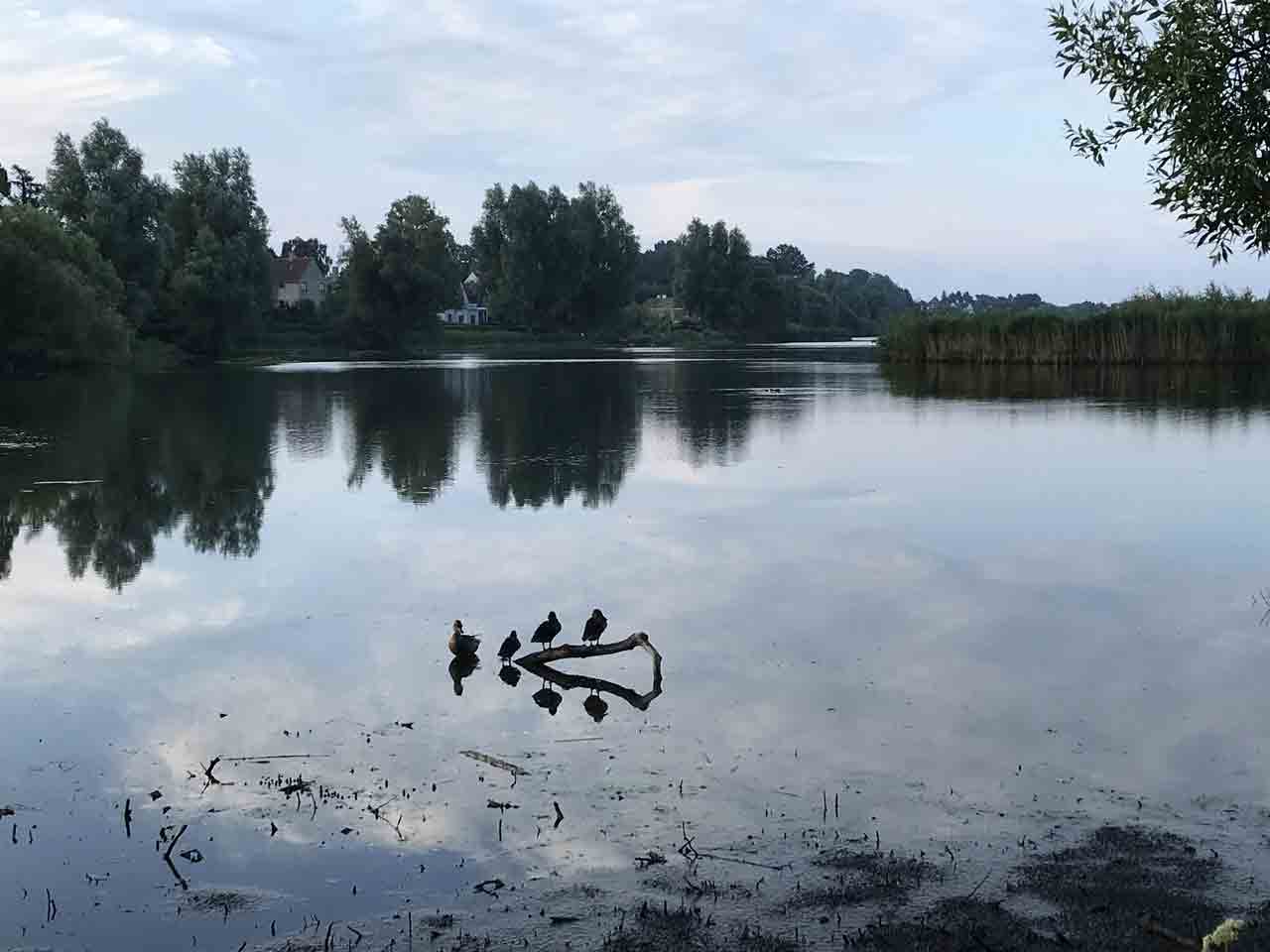
Gentofte Sø. Photo: Birgitte Bak
Description:
The lake of Gentofte Sø (just under 27 ha) and the bog of Brobæk Mose together form the largest wetland in the municipality of Gentofte, covering 53 ha. The lake is a very important locality with regard to plantlife and has a rich variety of species. The lake was originally the basis for commercial fishery, and there are still some old fishermen’s houses close to its bank. Until 1959, the lake was used as a water supply, and is today one of the purest lakes over 20 ha in the country. It was formerly much larger, but when the Helsingør motorway was extended around 1970, the area was reduced. On the west bank there are several islets with reedbeds, whilst on the east bank gardens reach down to the lake. On the east bank there is also a park (Folkeparken) with many old trees.
Brobæk Mose to the west of the lake was put under preservation orders in 1988. Peat pits, alder bogs and willow shrub still remain. The natural woodland in the bog is left untouched, so that new trees can grow up and old, fallen trees are left to decay. It is planned to preserve the open areas south of the bog (Gentofte Enge), where there are many rare plants: for example orchids.
Birds:
Breeding birds:
Several species of waterbirds breed at Gentofte Sø, for example great crested grebe, mute swan, greylag goose, mallard and coot. At least two pairs of tufted duck and pochard also breed here. The reedbeds house breeding water rail and moorhen, together with sedge warbler, marsh warbler, reed warbler and reed bunting. A few pairs of bearded tits nest every year and can often be seen from the pontoon bridge along the north-west bank of the lake.
Many common passerines can be found around the lake, including fieldfare and long-tailed tit. Up to five pairs of lapwing breed on the open area and many woodpigeons nest in the woodland, together with buzzard, sparrowhawk, great spotted woodpecker, treecreeper and jay. The rare lesser spotted woodpecker also breeds here sporadically – the last time being in 2016.
The old trees in the Folkepark with their many holes are favourite nesting places for many passerines. These include redstart, spotted flycatcher, treecreeper, nuthatch, starling, wren, great tit, bluetit and the less common short-toed treecreeper.
Migrating and staging birds:
In spring, flocks of great crested grebe, mute swan, greylag goose and goosander can appear in large numbers.
White-tailed eagle, goshawk, sparrowhawk and kingfisher are seen regularly.
During the migration season one can be lucky enough to see passing flocks of cranes, honey buzzards and sparrowhawks. Osprey is a regular visitor on migration and can be spotted catching fish in the lake. Woodcocks, snipe, jack snipe and green sandpiper use the bog as a staging post on migration.
Winter guests include heron, whooper swan, mallard, gadwall, shoveler, tufted duck, smew and coot. Water rails and bearded tits are seen in the reedbeds and a single bittern turns up every year. The many springs in the bog, which never freeze, are known to attract fair numbers of water rails and woodcocks – and birdwatchers – in winter.
More uncommon birds to be seen here include red-crested pochard, which has been a regular guest every spring since 2015. Great white egret was last seen here in October/November 2018 and September 2020. Since 2013, up to six Caspian terns have been observed fishing over the lake in the summer months – both adults and young.
Visiting and access:
The nearest S-train station is at Gentofte. From here, there is a walk of about 500 meters to the northern end of the locality. If you come by car, you can park on one of the roads around the lake. There are toilets next to the jetty on the south-east bank of the lake. A 5 km long path leads all the way round the lake and through Brobæk Mose.
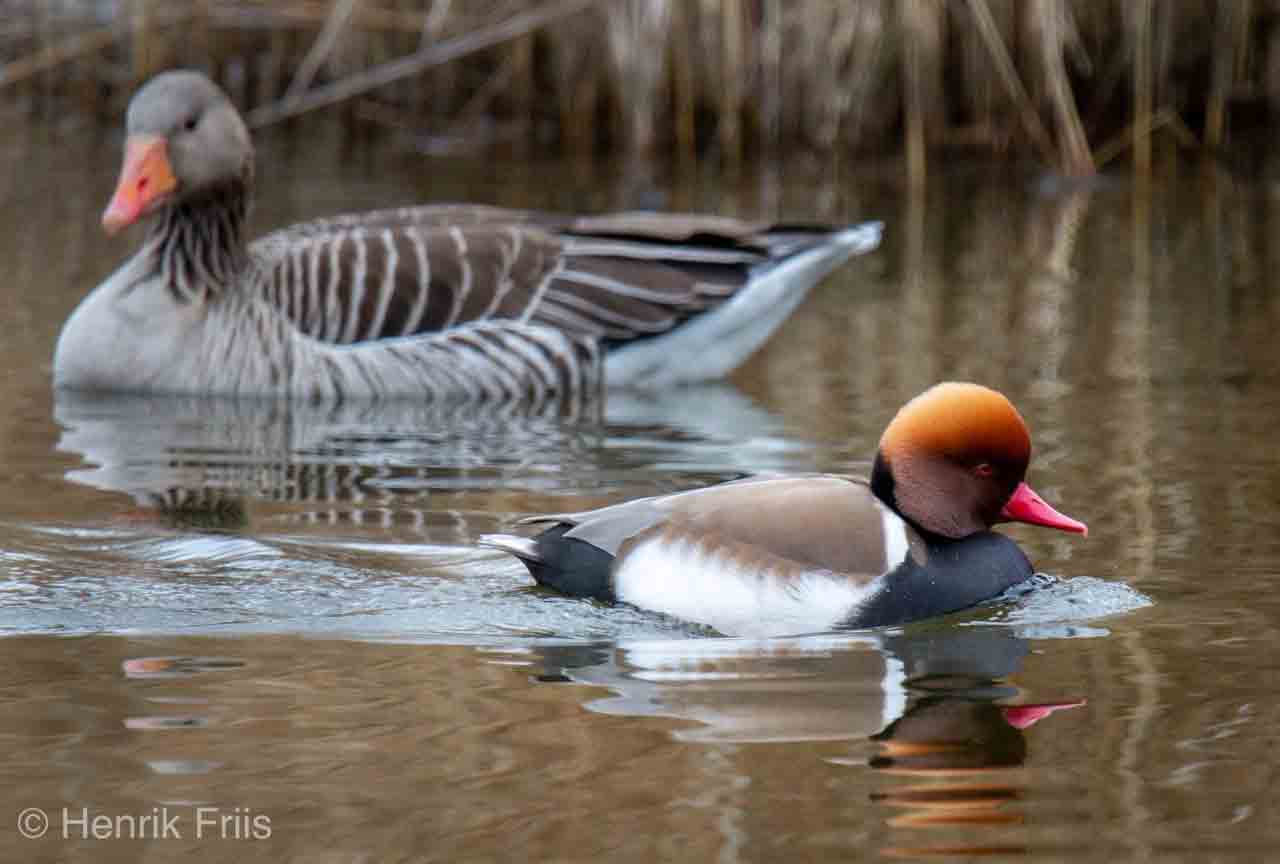
Red-crested pochard. Photo: Henrik Friis
Gilleleje
North coast of Zealand
One of the best places in Scandinavia for migrating passerines in spring, and a good site for watching raptor migration
See Google map with look-out points, car parks, etc.

Osprey. Photo: Per Ekberg
Description:
Gilbjerg Hoved, west of the town of Gilleleje, is the northernmost tip of the island of Zealand. Gilbjerg Hoved is a 33m high, steep moraine cliff covered with grass. The steep coastal slopes and the surrounding dry grasslands have a rich and interesting flora and butterfly population. East of Gilleleje is Nakkehoved lighthouse on top of the slope, surrounded by wood and scrub, and 1km inland to the south is the outlook point of Hesbjerg.
Birds:
Breeding birds:
Kestrel, tawny owl, various tits and warblers nest in the area.
Migrating and staging birds:
Migrating birds are the big attraction at Gilleleje. Huge numbers of passerines fly past in spring and autumn, and there is an impressive migration of raptors in spring. The number of birds passing over the area is very dependent on the direction of the wind. Autumn migration of seabirds is also impressive.
Spring migration starts at the end of February and goes on until the beginning of June. Each month, different species dominate.
From the end of February to March: goshawk, buzzard, stock dove, wood lark, skylark and jackdaw. The biggest flocks of cranes and chaffinches usually fly over at the end of March.
April: the first two weeks are normally the time when enormous flocks of passerines pass over Gilleleje. Finches are the most numerous species, but many others such as marsh harrier, hen harrier, sparrowhawk, rough-legged buzzard, osprey, kestrel, merlin, peregrine, crane, grey wagtail and various thrushes also appear.
May brings the birds that winter in Africa, mainly swallows, martins, warblers, swifts, yellow wagtails and pied flycatchers, but also more raptors, including honey buzzards and hobbies.
June: migration continues, although the number of birds is reduced. Swifts and spotted flycatcher pass by.
There is always the chance of seeing a rarity. In the past few years, the following birds have been seen: spotted eagle, lesser spotted eagle, black stork, white-winged black tern, turtle dove, Tengmalm’s owl, red-rumped swallow, alpine accentor, collared flycatcher, golden oriole, rose-coloured starling and pine grosbeak.
There is a good autumn migration of passerines, although the birds flying in from Sweden are not as numerous as those flying out in spring. On the other hand, more birds stop over here, and on days with fog or cloud the scrub can be full of activity.
Rarities seen during autum migration include hawk owl, Tengmalm’s owl, pallid swift, alpine swift, desert wheatear, Pallas’s leaf warbler, yellow-browed warbler, Radde’s warbler, dusky warbler, rose-coloured starling, pine grosbeak and rustic bunting.
From August to the middle of November there are chances of observing an imposing movement of seabirds and shearwaters. This happens if the wind is (or has been just previously) strong to gale force from the west or north-west. The seabirds can include red-throated divers, gannets, eiders, common scoters, kittiwakes, razorbills and guillemots. With any luck one can also see great northern diver, fulmar, sooty shearwater, Manx shearwater and one or two species of skua. White-billed diver, Cory’s shearwater and Sabine’s gull also show up from time to time. Great shearwater and storm petrel have also been spotted. If the wind is very strong and coming in from the north-west there is also the possibility of Leach’s petrel.
Seabirds can also be seen at other seasons – for example, summer is a good time to see Manx shearwater, and in winter kittiwakes, razorbills and guillemots fly past the coast – but not in the same numbers or the same diversity as in the autumn months.
Visiting and access:
From motorway E47/E55, turn off at exit 9 towards Hillerød. About 3km past Hillerød, turn right and continue to Gilleleje. Drive through the town and turn left at the roundabout towards Rågeleje. A few hundred metres further on is a car park. From here there is a path through the reserve and up to the Gilbjerg stone.
One can also take the S-train from Copenhagen to Hillerød and from there the Gribskov train to Gilleleje station. Walk or cycle through the town and along the coast on the Gilbjerg path, or take the bus from Gilleleje station to Gilleleje holiday center, from where there is a 10 minute walk to Gilbjerg Hoved. There are also trains from Helsingør to Gilleleje.
There are four good look-out points/bird localities at Gilleleje:
1. Gilberg Hoved is a cliff 2.5km west of the town of Gilleleje and one of the best localities in Denmark for observing spring migration, especially passerines. Hundreds of thousands of passerines fly over this spot on their migration north to breeding sites in Sweden, Finland, and Russia. Gilbjerg Hoved is the best place in the area to be if the wind is coming from the south or south-east. Many passerines settle in the surrounding bushes and scrub. Passerine migration usually dies down at the beginning of the afternoon but is succeeded by raptor migration.
2. The public area at the end of Vibehusvej (around 1km east of Gilbjerg Hoved) is a good place to watch seabird movements in autumn.
3. Nakkehoved (2.5km east of Gilleleje) is a good place to find staging passerines that frequent the scrub in the area around Nakkehoved lighthouse: warblers, thrushes, flycatchers, tits, etc. Many hirundines forage in the area. During spring migration over Hesbjerg, the dry meadow between the coast road and the eastern part of Nakkehoved can be an excellent viewpoint. There are car parks at Nakkehoved that can be reached by turning off the road to Hornbæk. There is also a bus to and from Gilleleje Station that passes this locality, and there is a path from Gilleleje along the coast.
4. Hesbjerg is a good place from which to observe raptors. It is best when the winds are light and especially when they are blowing from the east and south-east. Hesbjerg is around 1km inland from Nakkehoved and is the highest point in the area (50m) with a view across to Sweden, Hornbæk and the forest of Gribskov. On the top is a barrow with bushes and stunted trees. Hesbjerg can be reached by a farm track, but please do not walk on the fields. It is easy to reach the site by car by driving along Gillelejevej, then along Bregnerødvej and left along Hesbjergvej. It is possible to park at the end of the road and walk the last 100m up to Hesbjerg. The train from Gilleleje to Helsingør is also a possibility: get off at Firhøj and walk 1km north along Hesbjergvej.

Sparrowhawk. Photo: Per Ekberg
Gribskov
North Zealand
Interesting forest birds. Denmark’s largest population of breeding goldeneye, green sandpiper and red-backed shrike.
See Google map with look-out points, car park, etc.

Green sandpiper and red-backed shrike, Gribskov. Photo: Per Ekberg
Description:
Gribskov is the second largest forest in Denmark, covering in all 5600ha. It is situated immediately north of Hillerød and stretches north for around 15km, with the lake of Esrum Sø as its eastern boundary. In the middle ages the forest was owned by the church, but after the reformation the whole area was taken over by the monarchy and was used as a royal hunting-ground. Not until the end of the 18th century were the boundaries determined and forestry started in earnest.
The forest lies on a very hilly north-south ridge formed by moraine during the last ice age. On the highest points in the middle of the forest are large areas with spruce. On the lower areas to the east and west, where the earth is more fertile, deciduous trees such as beech and oak dominate. In the low-lying areas remains of old forestry practices can be seen, such as coppices of alder and ash, and grazing areas, of which some today are enclosed meadows with cattle grazing. Between the hills there are bogs, ponds and springs.
The forest is of important commercial interest and is also used intensively for recreational purposes.
Birds:
Much of the birdlife in the forest is concentrated around the large clearings and the areas with water. In the forest both the usual and also more unusual forest birds are found, such as woodcock, stock dove, tree pipit, redstart, wood warbler, pied flycatcher, bullfinch and hawfinch. The green sandpiper population is of special interest: with over 20 breeding pairs it is the biggest population in Denmark. The population is stable and may even be on the increase, probably because more and more areas in the forest are being put under water. Another interesting bird – the black woodpecker – that recently suffered a sharp decline, is now present in nearly the same numbers as previously. In 2009 the population was at a low with a maximum of 6 pairs, but in 2019 there were 12-14 pairs. Another species of woodpecker, the rare lesser spotted woodpecker, has during the last few years established a population of more than 10 pairs. In 2017 yet another woodpecker species, wryneck, started to breed, and there are now 8-10 regular breeding pairs.
Kingfisher nest regularly every year with a few pairs. Firecrest can be heard singing every year in various parts of the forest and up to 30 pairs breed here each year. Short-toed treecreeper was found nesting here for the first time in 2008 and the population is now more than 15 pairs, that are mostly concentrated in the eastern part of the forest, near Esrum Sø. Red-backed shrike is characteristic for the forest, where there are more than 100 pairs. There is a good population of raven in the forest which is on the increase. In the winter months, flocks of up to 50 birds are seen. Several species usually connected with the large forests in northern Scandinavia also breed in Gribskov, in some years in fair numbers. These include siskin, crossbill, bullfinch and now and again nutcracker. 4-8 pairs of breeding two-barred crossbill were a surprise in 2012, 2014, 2015 and again in 2018 . Four of the pairs were seen with young.
Gribskov has a population of breeding goldeneye that is unique in Denmark. This is due to the nesting boxes that have been put up round many of the lakes. Several pairs also nest in black woodpecker holes or hollow trees. Other breeding birds on the lakes are little grebe, greylag goose, tufted duck and teal.
There is a good and stable population of raptors: honey buzzard, buzzard, goshawk and sparrowhawk. Red kite have bred here since 2007 - the number increasing to 4 pairs during the last few years. Osprey nested in the forest for the first time in 2012 (north-west of Lille Gribsø) and succeeded in raising two young. Since then they have bred nearly every year and in 2019 succeeded in rearing three young. In 2018 another osprey built a nest in the forest, but there has been no breeding success as yet. The areas around the nests are now closed for the public from 1st April - 1st September. White-tailed eagle has also started to nest here and there are now two pairs in the forest The first pair has bred successfully since 2015 in an area in the north-eastern part of the forest, which is closed to the public.
Gribskov has an impressive concentration of breeding birds. The last counts from 2017 show no less than 100 different breeding species. The latest addition is a fair-sized population of woodlark in the middle of the forest.
Other animals:
In Gribskov it is possible to see all four species of Danish deer living in the wild. Apart from roe deer and the occasional red deer, both fallow deer and sika deer can be found. Fox, badger and pine marten also live in the forest, and beaver has recently turned up.
Visiting and access:
The forest can be accessed by all the forest paths. If coming by car, one can either drive in the direction of Tisvilde along Helsingevej (turn off route 19) or towards Gilleleje on route 227 (exit from route 6 between Hillerød and Helsingør - turn off onto Nødebovej). Both roads pass through Gribskov, where there are many places to park and start walks into the forest. One can also take the train from Hillerød – either in the direction of Tisvilde or Gilleleje. There are several stations and halts on both stretches. In the forest there are many spots with picnic tables and barbecue facilities.
It is recommended to make use of the maps in the Nature Agency’s four leaflets about different sections of Gribskov. They can be downloaded here.
North of the lake of Esrum Sø is the monastery of Esrum Kloster and Esrum Møllegård (mill), that are open for the public and worth a visit. At Møllegård one can be lucky enough to see the grey wagtail that nests here.
South of Nødebo, in the south-westerly end of Esrum Sø, is the inlet of Møllekrogen. From route 6 between Hillerød and Helsingør, take the turning for Nødebo (Stenholtsvej) at the roundabout. After around 400m there is a car park on the left-hand side. On the opposite side of the road, a path leads to an observation tower. There is a view over scrub, reedbeds and a corner of the lake, and a good view of the cormorant colony in the boggy wood.
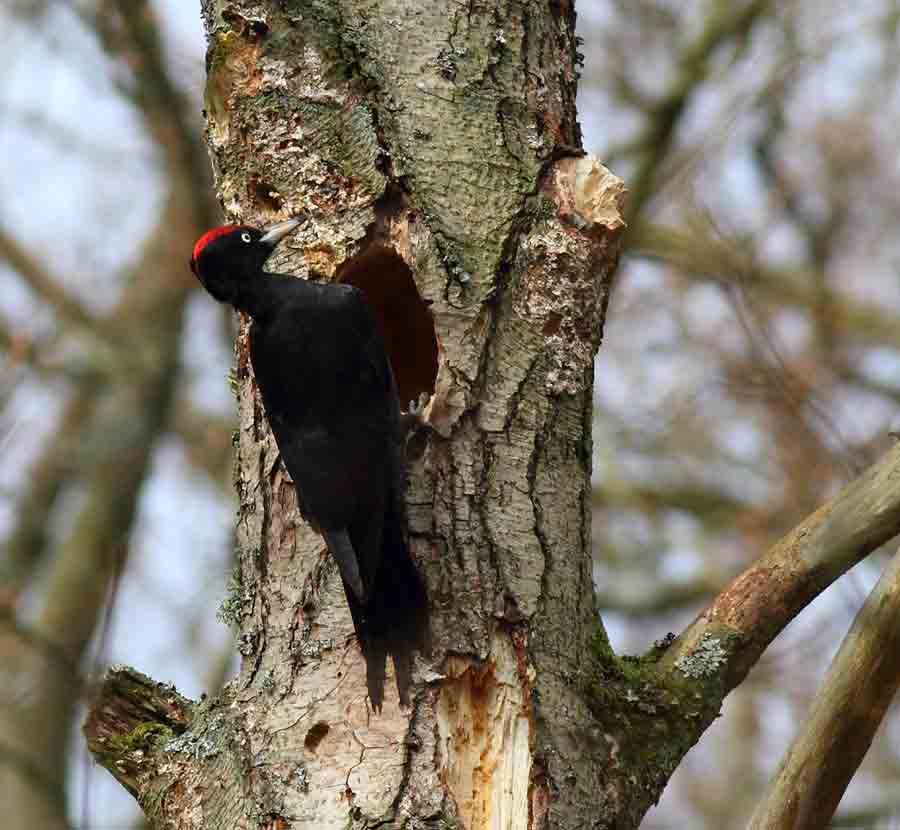
Black woodpecker, Gribskov. Photo: Per Ekberg
Gundsømagle Sø
North Zealand, east of Roskilde Fjord
Bird reserve with breeding waterbirds and passerines
See Google map with bird observation towers, car parks, etc.
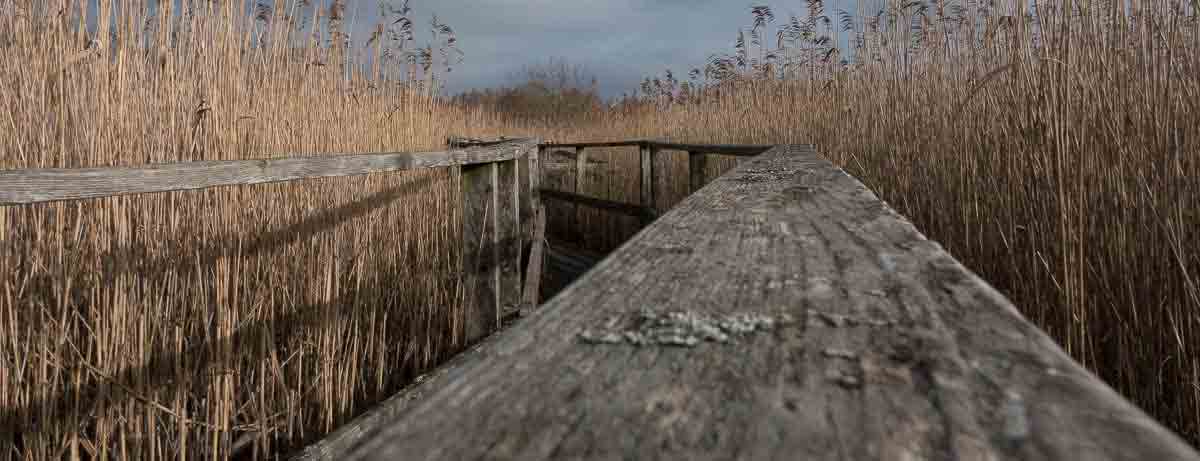
Boardwalk, Gundsømagle Sø. Photo: Erik Agertoft
Description:
The area covers over 300ha. Apart from the lake it comprises large reedbeds, willow and birch scrub, peat ponds and meadows, as well as bog, woodland, fields and grassy slopes. In 1984, the Danish Bird Protection Foundation purchased 60ha of the area to re-establish the lake.
Until 100 years ago, the lake had some of the most prolific birdlife in the whole of northern Zealand, with several rare breeding birds. However, the lake became badly polluted in the course of the 1950s and 1960s as waste water was led into the lake without being purified. All the vegetation in the lake died, the lake bed became muddy and the water was filled with plankton algae, so that the birds disappeared. Even though the lake no longer receives as much waste water as before, the water is only clear for a depth of 20cm in the summer months, and it unfortunately looks as if many years will be needed before the nutrient pollution declines and the water quality improves.
The area around the lake is managed by ensuring that the water level in the lake and the reedbeds is as high as possible and by harvesting the reeds at regular intervals.
Birds:
Even though Gundsømagle Sø can no longer boast as many bird species as previously, it is still a good site for seeing some of the most common passerines and for getting close to the birdlife in the reeds. The best time to come is in spring and autumn.
Breeding birds:
Around 100 pairs of different species of passerines nest in the area. Wren, robin, blackbird, fieldfare, tits, treecreeper, short-toed treecreeper, blackcap, redstart and chaffinch can be seen or heard in the woods. The old trees in the wood are left standing, and therefore have many cavities that are used for nesting by woodpeckers, tits and starlings. A pair of tawny owls usually nest here every year.
The reedbeds at Gundsømagle Sø are the largest in eastern Denmark. In the reedbeds and scrub there are breeding water rail, thrush nightingale, sedge warbler, reed warbler, marsh warbler and reed bunting. Bearded tit is another bird that can be spotted - especially from the boardwalk that goes out into the reedbeds at the western end of the reserve. The bearded tits nest in old, unharvested reedbeds and sometimes appear in flocks of up to 30 birds, many of which are young birds that are fed by the adults. During the last few years, bluethroat has been spotted sitting and singing from the bushes in the reedbed to the west of the westernmost bird observation tower. The marsh harrier has often attempted to breed. It can be seen gliding over the reeds from April to October.
Great crested grebe, mute swan, greylag goose, mallard and coot nest around the lake.
Migrating and staging birds:
Cormorant and grey heron can be seen foraging in the area throughout the year. Buzzard and pheasant are regular guests. In early spring, one can be lucky enough to see osprey over the lake.
In winter, large flocks of tufted duck can be seen on the lake, where they spend the daytime resting. At night they fly out onto the Roskilde Fjord to feed. Pochard and goldeneye can also be seen on the lake. Mallard, gadwall and widgeon are regular guests from August to April. Goosander and smew are often seen from the observation towers in winter. Large numbers of greylag goose and barnacle goose stage on the lake when it is not frozen over. Hen harrier and rough-legged buzzard can be seen flying over the meadows and the reedbeds.
Other animals:
On the western side of the wood there is a pile of stones where grass snakes lie and bask in the sun spring and summer. The stones can easily be seen from the boardwalk/path, but it is best to walk quietly, as otherwise the snakes will quickly disappear between the stones.
Roe deer, fox, badger and hare inhabit the reserve.
Visiting and access:
About halfway between Roskilde and Ølstykke on route 6, turn off east and drive through Gundsømagle to the village of Østrup at the eastern end of the lake. Coming from the south or the east, drive via Sengeløse, Veksø or Smørumovre. In Østrup a sign points to the car park at St. Valbyvej opposite the farm of Østrupgård. From here there is access to the lake.
It is also possible to reach the southern bank of the lake on a small farm track leaving a car park on Kirkerupvej between Kirkerup and Østrup.
There is no access into the reserve itself, except along the paths from the two car parks on the southern bank, from where there are good views over the lake, reedbeds and meadow. The observation towers are covered, and are joined by an 800m long boardwalk. In the reedbeds west of the western tower is a 300m long boardwalk. Here there are good possibilities of experiencing the birds and the wildlife in the reedbeds at close range.
The Bird Protection Foundation has published four folders about the area that can be picked up in the reserve or downloaded from their website on Gundsømaglesø.
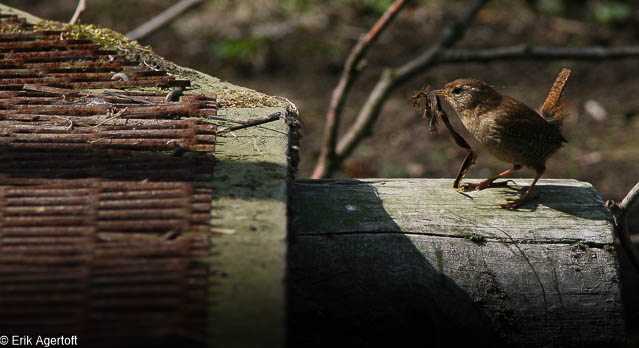
Hellebæk
North coast of Zealand
One of the best known localities for both spring and autumn migration.
See Google map with look-out points, car park, etc.
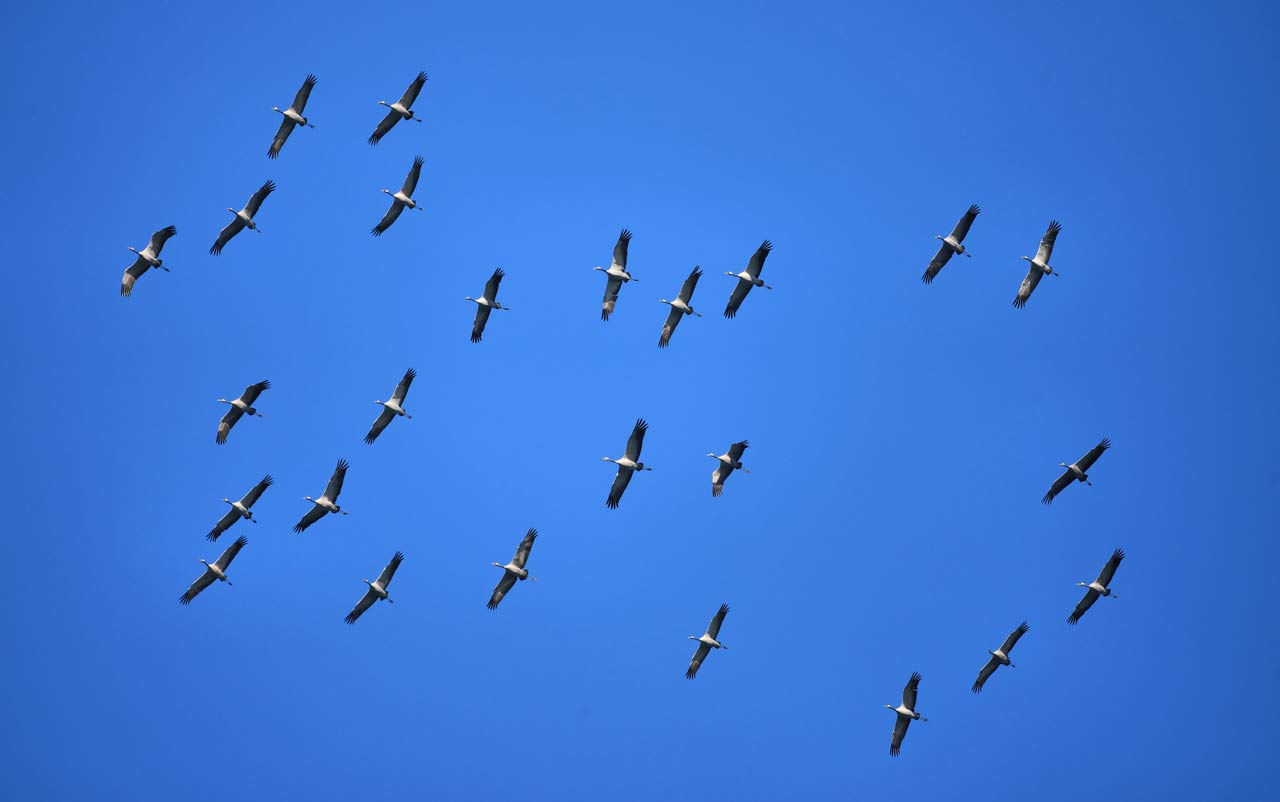
Hellebæk is on the north coast of Zealand, around 15km east of Gilleleje. It lies between the forests of Teglstrup Hegn and Hammermølle Skov north-west of Helsingør. Inland from the coast, the landscape is hilly with mixed conifer and deciduous woodland (mostly beech), arable land and grassy fields, ponds, streams, and birch and alder scrub.
Breeding birds:
Greylag geese breed in Hellebæk Kohave, which is meadowland grazed by cattle, and surrounded by woodland and lakes. The geese can best be seen at the lake of Pernillesø, where there are also little grebe and red-necked grebe. With luck, one may see lesser spotted woodpecker and hear thrush nightingale singing in the alder scrub in springtime. Short-toed treecreeper, black woodpecker and green sandpiper are regularly seen and heard in the surrounding woodland.
Migrating and staging birds:
It is especially the migrating raptors and cranes, that can pass by in thousands, that make this area a special one. On autumn migration, buzzards are the most numerous raptors, and the diversity of raptor species is not so high. Honey buzzard, black kite, red kite, white-tailed eagle, marsh harrier, hen harrier, goshawk, sparrowhawk, buzzard, rough-legged buzzard, osprey, kestrel, merlin, hobby and peregrine are seen regularly. Pallid harrier, golden eagle, lesser spotted eagle and spotted eagle are seen only in very small numbers. White stork is seen every year, but black stork is rare. Spring migration of crane is impressive: especially when the wind is coming from the east there can be days with over a thousand birds. Spring migration begins in March, when the first raptors to arrive are buzzards, followed by goshawk and red kite.
Cranes fly past the hills at the former Avlsgård farm (now demolished) in their hundreds on spring afternoons with south-easterly and easterly winds. They are on their way from the island of Rügen off the north coast of Germany to Hornborgasjön in Sweden. On the best days, over 1000 cranes can be seen in one afternoon. Barnacle geese are mostly seen in April, and brent geese are particularly abundant at the end of May.
In autumn, migration starts at the end of August with a few honey buzzards and ospreys, but the best migration days are from the last week in September to the middle of October, when one can be lucky enough to see over 4000 buzzards in one day. White-tailed eagle is also seen every year in October. There is sometimes a good migration of divers, razorbills, guillemots, pigeons and crows over the sea.
Turn off motorway E47 at exit 3 towards Espergærde.and drive around 5km north in the direction of Ålsgårde. Turn right at the roundabout in Nygård and after 300m left along a gravel track (Hellebækvej) past the riding school. After around 1km you will reach the car park at the site of the now demolished farm of Hellebæk Avlsgård.
There are several good sites in the area for observing migration, dependent on the season and wind direction.
Spring migration: the most popular observation site is the open hillside around the demolished farm of Hellebæk Avlsgård. If the wind is strong and north-westerly it can be a good idea to stand on the coast near the castle of Kronborg.
Autumn migration: there are various places on the coast where there are good views of the raptors approaching land. This migration covers quite a broad front from Ålsgårde in the north to Kronborg in the south. In autumn, it is the wind direction that determines where the migration will be concentrated. As a general rule, the following sites are the best:
Julebæk in south-westerly winds / Højstrup beach in westerly and north-westerly winds / Kronborg in north-westerly and northerly winds / the coast at Hellebæk Gl. Klædefabrik (the old clothing factory) in southerly, south-easterly and easterly winds / the coast at Ålsgårde in south-easterly winds, especially if the wind is regular and strong / the hills at the former Avlsgård are sometimes good if there is a really strong south-easterly wind.
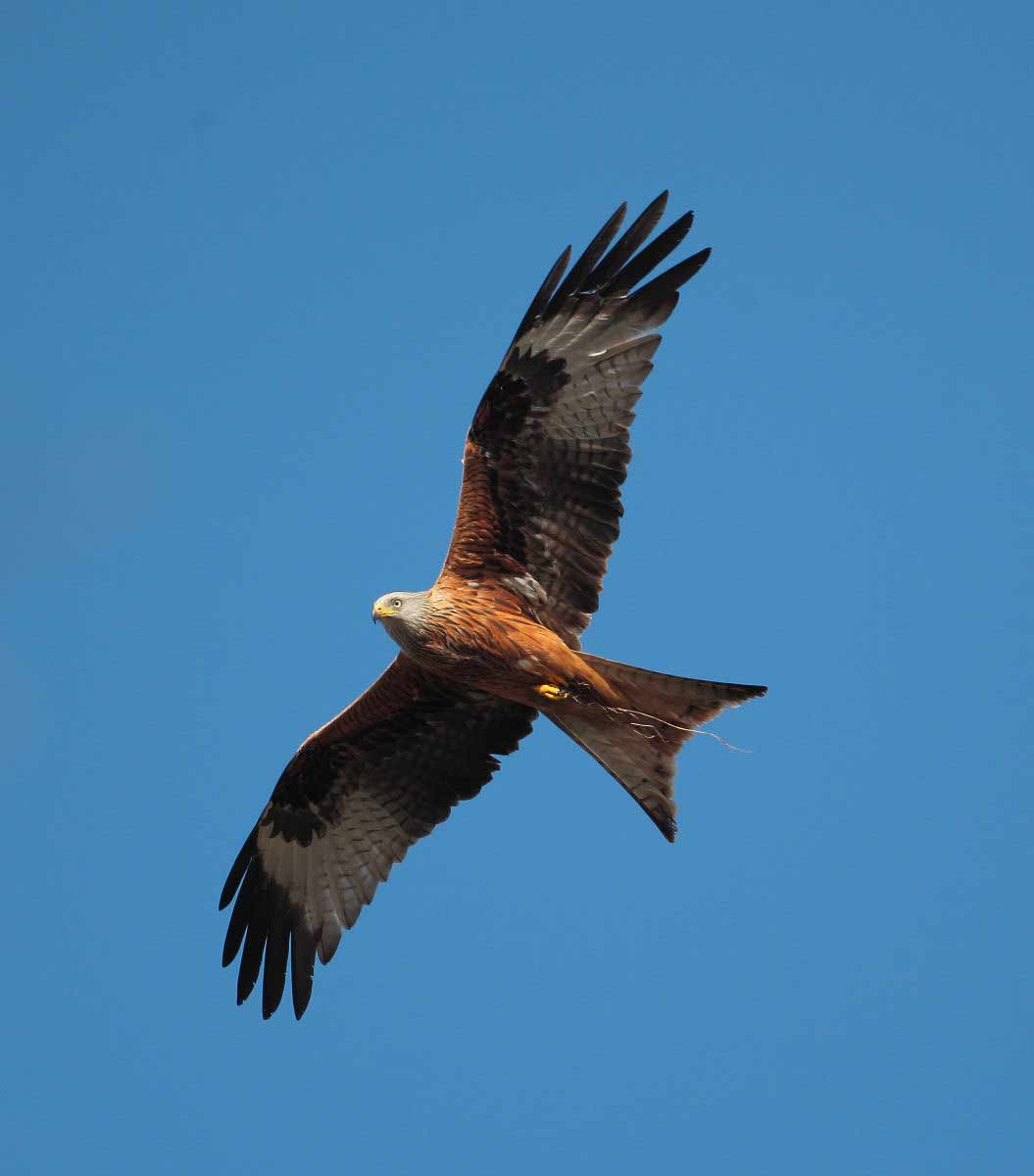
Holmegaards Mose and surroundings
Southern Zealand
Zealand’s largest raised bog with many breeding waterbirds and marsh birds
See Google map with car parks etc.
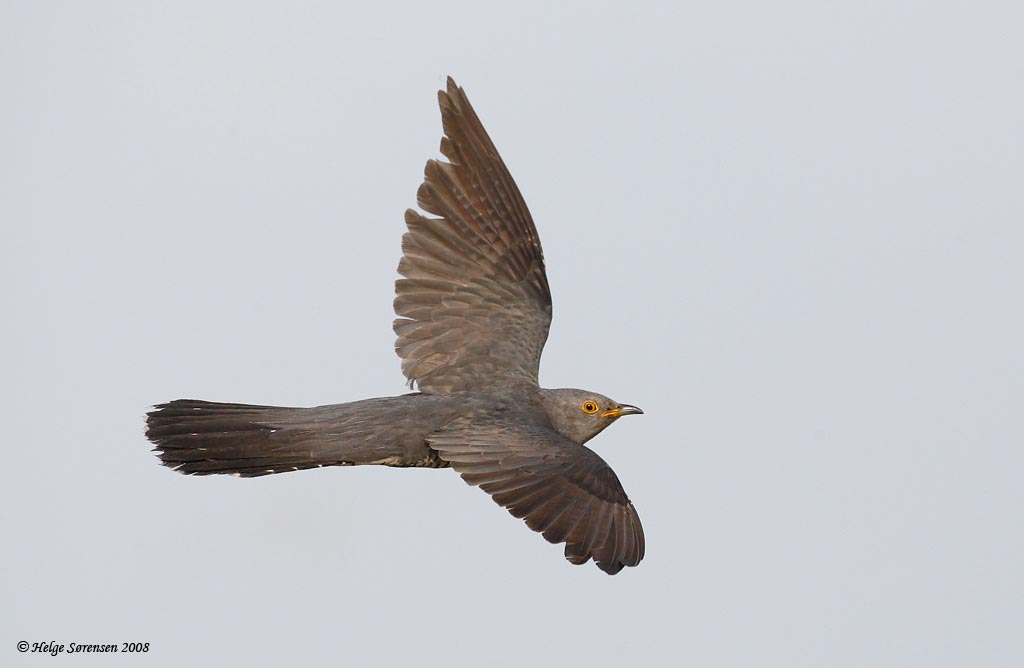
Cuckoo (adult male). Photo: Helge Sørensen
Description:
Holmegaards Mose is the largest raised bog on the island of Zealand. 326ha of the area are under preservation orders, of which 40ha are raised bog. After the ice age, the whole area was a large, shallow lake, which gradually became overgrown with alder trees and bog moss. It took several thousand years to form the present raised bog. In 1825, the Holmegaard glassworks were built south of the bog and the peat was used as fuel until 1924. Peat digging continued for other purposes, however, until the 1950’s. Many of the peat trenches then filled up with water and became overgrown. Nitrogen pollution from farmland, systematic draining and intensive forestation and agriculture were, however, highly detrimental to the natural state of the area.
To the east of Holmegaard Mose is Porsmose, covering 4-500ha, in the southern part of which is a newly established lake, created in 2003, called Gødstrup Sø. The area was previously a bog that was used for peat digging in the 1800’s. Subsequent attempts to drain and cultivate the area had little success. Since the lake has been established, reedbeds have spread along most of its banks.
The Holmegaards Mose area also includes Broksø Enge, a low-lying area of meadows with some re-established ponds running alongside the Suså river between Porsmose and Broksø.
A large-scale EU LIFE project, which ran from 2010 to 2013, aimed at restoring part of the raised bog. The water level was raised, a large 40ha area of trees was cleared, and sheep were put out to graze part of the area. 150ha of open bog were recreated. The Suså and Jydebækken watercourses have been restored and now meander through the area on either side of the bridge at Røde Bro. As a result, the meadows in the eastern section of Holmegård Mose and in Porsmosen have become decidedly wetter and this has been a great benefit to the birdlife here.
Birds:
Breeding birds:
Breeding birds have a difficult time at Gødstrup Sø, as the water running into the lake is not regulated and sudden rises in water levels in the breeding season means that nests, eggs and young are lost. Despite protests from green organisations, the authorities have up to now insisted that the flooding should continue.
However, the rest of the area supports many breeding waterbirds: Holmegaards Mose houses red-necked grebe, mute swan, tufted duck, mallard, moorhen and coot. Great crested grebe has started to breed. Gadwall have been seen showing courtship behaviour in the Suså and Jydebækken watercourses. Bittern and water rail breed in the reedbeds. There is a good chance of seeing one of the 7 pairs of cranes that nest in the area and that turn up from the second week in January. Waders include lapwing and snipe. A more unusual breeding bird is lesser spotted woodpecker.
Every year, black-throated grebe and black-headed gull try to nest at Broksø Enge, together with various ducks, redshank, lapwing and snipe.
Many passerines can be observed in the area, including many willow warblers and chiffchaffs in the willow scrub. Cuckoo is heard throughout the summer months. The meadows and fields at Røde Bro house 3-4 pairs of whinchat together with marsh warbler and grasshopper warbler which are regular summer guests. There is also a chance of hearing corncrake from the bridge, where it is heard every year. Some years it can also be heard at Gødstrup Sø.
Several pairs of marsh harrier nest in the bog and forage here throughout the summer. The white-tailed eagles that breed in the vicinity can often be seen hunting over the meadows along the Suså and in Gødstrup Sø.
Migrating and staging birds:
Gødstrup Sø, Broksø Enge and the meadows on either side of Rødebrovej are the best places for observing migrating and staging birds.
Flocks of bean goose, white-fronted goose, greylag goose and barnacle goose often stage on the fields and meadows in the area in mid-winter.
In Gødstrup Sø, widgeon and greylag goose are seen in their hundreds every autumn, and bean goose, white-fronted goose and mute swan appear regularly in large numbers. Hen harrier is a common winter guest.
Broksø Enge is an important staging and foraging site for whooper swan, geese and ducks, especially in late winter and early spring.
Porsmose is one of Denmark’s most important staging localities for bean geese. The meadows on either side of Rødebrovej are staging and foraging sites for large flocks of geese, ducks and waders. Widgeon, redshank and lapwing, especially, can be seen in large numbers, but also ruff (in autumn). In rainy periods, the meadows in Stude Mose and Porsmose become flooded and attract dabbling ducks such as mallard, widgeon, teal and pintail, and also greylag geese.
Large numbers of white-tailed eagle can often be seen congregating here - up to ten at a time - usually young birds. In addition, the local breeding pair turns up daily. Young golden eagle are also spotted, although not every year. Red kite is seen almost daily and peregrine falcon during most of the winter season on the meadows at Porsmose. The meadows also attract a good many raptors, including buzzard, rough-legged buzzard, hen harrier and kestrel.
A new attraction is the cranes that stage here throughout the year. The numbers of great white egret seen here have increased steadily during the past few years, with a maximum of 68 at one time. A new visitor to the area is stonechat, that can be seen on the meadows at Røde Bro both spring and autumn, although there are as yet no signs of attempts to breed. Great grey shrike is a regular winter guest.
Visiting and access:
One can approach Holmegaards Mose by various routes. One possibility is to drive to the village of Fensmark, north of Næstved, and continue out of the village on the Fensmark Skov road in the northern end of the village. One can park next to the wood (Fensmark Skov) just outside the village on the right-hand side of the road. From here one can walk through the wood on a trail marked with blue signs, until one reaches the open bog. By continuing along the path, one can walk all the way round the bog. It is also possible to drive out of Fensmark along the Holmegårdsvej (eastwards) and turn left along Rødebrovej just outside the village, after which one reaches a car park to the left. From here it is also possible to reach the bog.
By continuing further along the Rødebrovej one reaches a bridge (Røde Bro) over the Suså, where there is a handicap-friendly observation platform and a car-park with room for 8-10 cars. From the platform there is a good view across the meadows.
It is difficult to access Broksø Enge, but the area can be viewed with a telescope from the roadside along Broksøvej.
It can be difficult to get a good view of the birds in Gødstrup Sø, but there is a good view over the lake and surrounding bog from the main road north of the village of Gødstrup. By following the road northwards and round a few bends, one can find a path following the railway line that leads down to Gødstrup Sø and Porsmose. About 1½km along the path is a little mound, from where there is a good view of the lake. A telescope is advisable here. One can also follow the northern and western sides of the lake by following Ravnstrupvej. From here one can look across the meadows at Porsmose, which can be interesting, but one cannot see much of Gødstrup Sø apart from a small portion of its northernmost end.
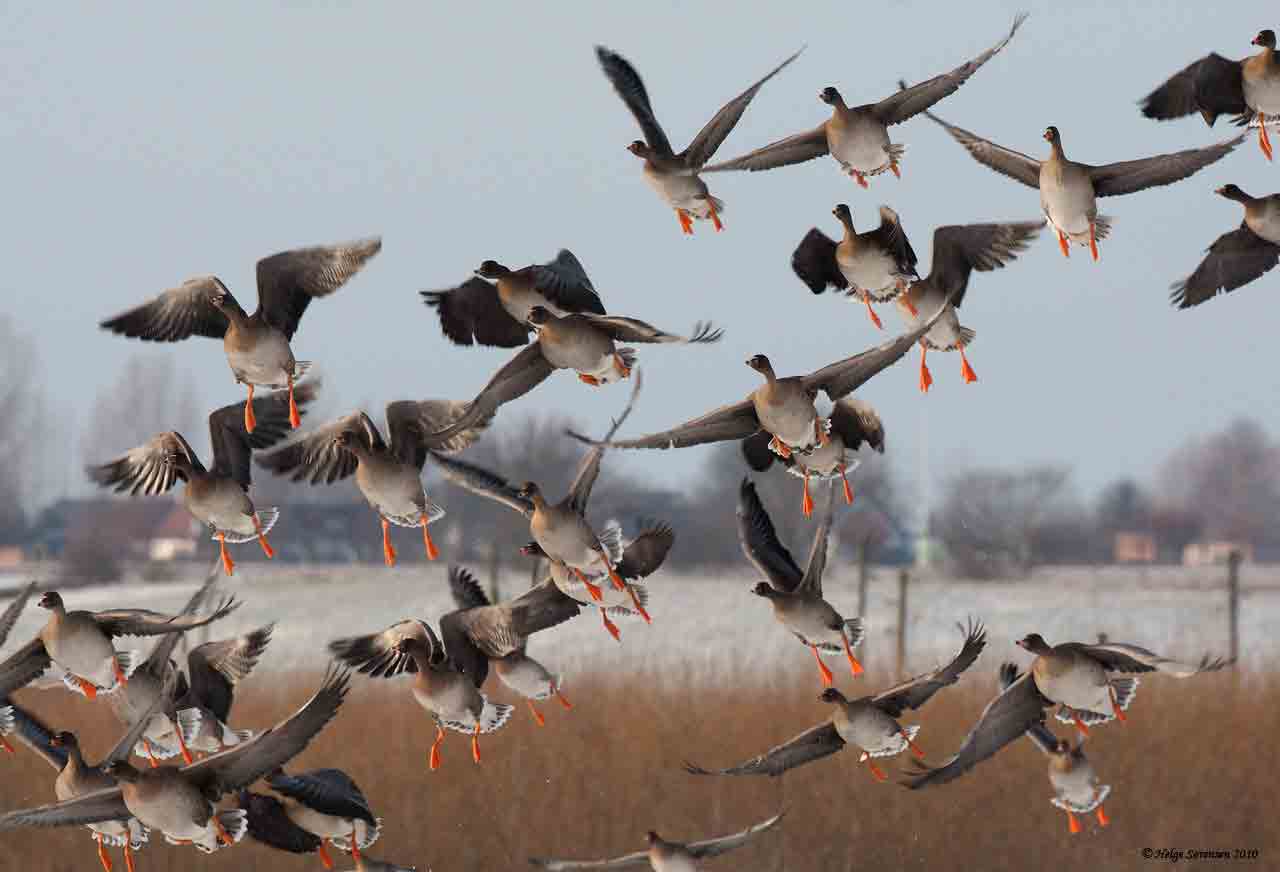
Bean geese. Photo: Helge Sørensen
Jægerspris Nordskov
Hornsherred, the peninsula between Roskilde Fjord and Isefjord
Several breeding raptors and red-backed shrike, hole-nesting species and common woodland birds
See Google map with car parks etc.

The Royal Oak. Photo: John Hansen
Description:
Jægerspris Nordskov is one of Denmark’s large areas of forest. It covers 13km2 of the north-eastern area of the Hornsherred peninsula and is made up of four forests: Fællesskoven to the west, Studehaven to the east, and Kohaven and Slotshegnet to the south. They form a 10km long unbroken line of deciduous woodland stretching down the western side of Roskilde Fjord between Kulhuse in the north and Jægerspris in the south.
The Nordskov forest is situated on hilly ground with poor sandy soil. In some areas, sitka spruce, pine and birch are the commonest trees. Fællesskoven and Studehaven contain many small ponds and bogs in the area nearest the coast. The most famous giant oak trees in Denmark can be found here, too: “The Stork Oak” (Storkeegen) and “The Grass Snake Oak” (Snogegen) (both of them now dead) and “The Royal Oak” (Kongeegen) which is 1400-2000 years old but still alive. Nearby is Bredvig Mose, which is untouched woodland with alder, ash, oak and beech, and further west is the pretty lake of Kongens Lyng. In the southernmost part of Studehaven is Grønnelyng, an area with lakes which is unfortunately very much marked by the practice of feeding mallards for hunting purposes.
Kohaven is mainly deciduous woodland, with many beech trees, and Slotshegnet, being near a town, has many visitors. It forms part of the park around Jægerspris castle.
Between the forest and the fjord are wide expanses of meadow: the Nordskovsenge. On the most easterly point is the Dyrnæs jetty, which used to be a place of disembarkation for a former brick factory. Around the jetty is a large area with mudflats and shallow water. To the west of Nordskov are wide open areas used for military exercises. The little island of Øksneholm lies just off the coast at the southern end of the meadows.
The forest is owned by a foundation known as Kong Frederik d. VIIs Stiftelse på Jægerspris.
Birds:
Breeding birds:
In the forest, breeding birds include the commonest woodland birds to be found in northern Zealand, such as tree pipit, thrushes, long-tailed tit, marsh tit, coal tit, treecreeper and hawfinch. The many old trees attract cavity-nesting birds such as stock dove, black woodpecker, lesser spotted woodpecker, redstart, pied flycatcher and nuthatch. Wood warbler can be heard every year. Raven also breed in the woods. A number of raptors nest here: white-tailed eagle, honey buzzard, buzzard, goshawk and sparrowhawk. Nightjar is heard in the northern parts of the forest which also house breeding woodcock.
Red-backed shrike breed in the area and can be seen in the hedgerows and at the edge of the wood, in clearings in the forest and in bushes on the meadows.
Migrating and staging birds:
The meadows of Nordskovsenge and the shallow water and mudflats along the coast attract waders on spring and autumn passage. Ducks, geese and swans congregate out on the fjord.
White-tailed eagle is seen in the area throughout the year and osprey is often seen on migration in spring and autumn.
In winter, rough-legged buzzard, hen harrier and great grey shrike can be seen on the military exercise grounds to the west of the forest and on the meadows to the east. Small flocks of twite often forage on the meadows. Crossbill is a regular winter guest in the woodland.
Visiting and access:
Jægerspris is situated in the northern part of the Hornsherred peninsula and can be reached from route 53 between Frederikssund and Lyngerup. If coming from Frederikssund, turn right on route 207 just after crossing the bridge over Roskilde Fjord. If coming from the south, turn left onto Landerslevvej in the town of Lyngerup. There are parking facilities at Jægerspris castle, at Skoven church (north of Jægerspris on route 207) and at the end of Barakvej in Kulhuse. There is also a large car-park inside the military area at Louiseholm, which can be reached by turning off Kulhusvej onto Nygårdsvej. Please note that the road may be closed if military exercises are underway.
If using public transport, take bus 316 from Frederikssund Station in the direction of Kulhuse and get off at Jægerspris at Slotskroen (the “Castle Inn”, which is in fact no longer an inn) next to the castle; at Skoven church; or at the Barakvej terminus. Bus 230R from Frederikssund Station is also a possibility, but it goes only as far as Jægerpris. Here one can get off at JAS (Jægerspris Amatør-Scene - ask the busdriver to tell you when to get off), from where there is a 75m walk to Slotshegnet.
One can also get off at Vænget, walk down Vængetvej and turn right along the embankment towards the little harbour at Vænget, from where there is a fine view across to Øksneholm, which is bird islet in Roskilde Fjord.
Jægerpris Nordskov is a private forest with public access. It is permitted to walk or cycle on roads and paths in the forest during daylight. The paths are generally good. There are good handicap-friendly roads into the forest from the main car-parks, but the smaller paths can sometimes be more difficult to walk on. It can be an advantage to use the folders issued by the Kong Frederik d. VII’s Foundation, as they have maps covering the different parts of the forest. These can be purchased from the foundation’s internet shop (see link below). The foundation runs a children’s home at the castle, where there is also a museum that may be of interest.
The foundation has an English language website which can be downloaded here.

Red-backed shrike. Photo: Gerner Majlandt
Kagsmosen
Husum west of Copenhagen
Many birds in a little natural oasis surrounded by buildings
See Google-map
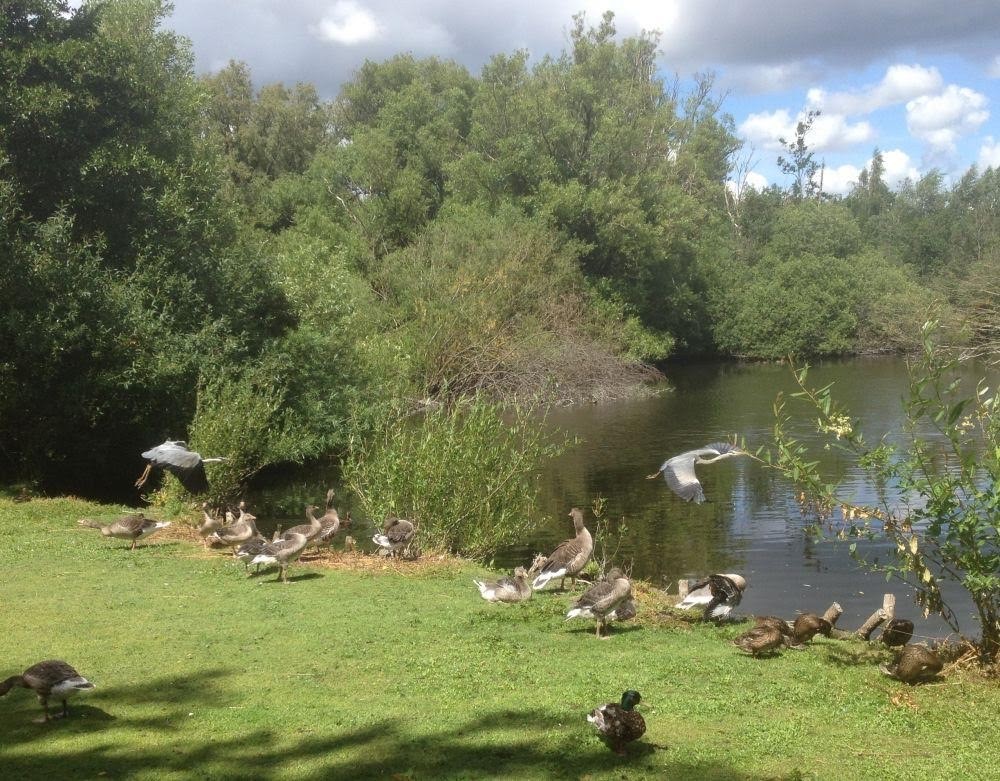
Kagsmosen. Photo: Frank Desting
Description:
Kagsmosen is a little, protected bog, squeezed in between a motorway and a built-up area. In the 1800’s, the boggy and impenetrable area formed part of the large fortification complex which surrounded Copenhagen. In 1939 work started on opening up the area for the public and paths were laid out. The area is now a park but has kept much of its former appearance with several lakes formed by peat-digging, reed beds and canals. In some parts, nature management is being carried out for the benefit of animals and plants.
Birds:
Breeding birds:
Breeding waterbirds include little grebe, red-necked grebe, mute swan, greylag goose, mallard, tufted duck, moorhen and coot. The area also houses breeding great spotted woodpecker, jay, long-tailed tit, fieldfare and thrush nightingale, as well as many warblers, including reed warbler and marsh warbler. Wren, dunnock, starling and reed bunting also breed regularly. The relatively rare penduline tit has bred here formerly. Short-toed treecreeper has been nesting here since 2012. Buzzard and marsh harrier breed here some years. Sparrowhawk occasionally nests in the area – sometimes in the trees on the remaining rampart known as Vestvolden next to Kagsmosen.
Migrating and staging birds:
Both in spring and autumn, Kagsmosen is a good locality for observing migrating and staging birds. Wildfowl such as greylag goose, teal, spoonbill, tufted duck and pochard can be seen and raptors such as buzzards, a few honey buzzards and sparrowhawks. Now and again red kite, goshawk, rough-legged buzzard, white-tailed eagle, osprey, hen harrier, marsh harrier and merlin can be spotted. Cranes pass over every year. Typical waders are lapwing, common sandpiper, snipe and woodcock. Other migrating guests include skylarks, hirundines, pipits, thrushes, warblers and finches. Spotted flycatcher and pied flycatcher can be seen staging here every year.
In the winter months, many wildfowl turn up, including mute swan, teal and tufted duck, and occasionally goosander, grey heron and coot. Raptors include sparrowhawk and buzzard. Apart from many different passerines, it is sometimes possible to see dipper and in certain years flocks of invading waxwings. A few years ago, short-toed treecreeper started to overwinter here. Kingfisher is a seldom but regular guest in the area.
Visiting and access:
It is easy to reach Kagsmosen by public transport. Bus 350S from Copenhagen stops at Herlev Hovedgade/Frederikssundsvej right next door. One can also take the S-train to Husum Station which is right next to Vestvolden and the bog.
If you come by car you can park on Vindingevej near Husum Station.
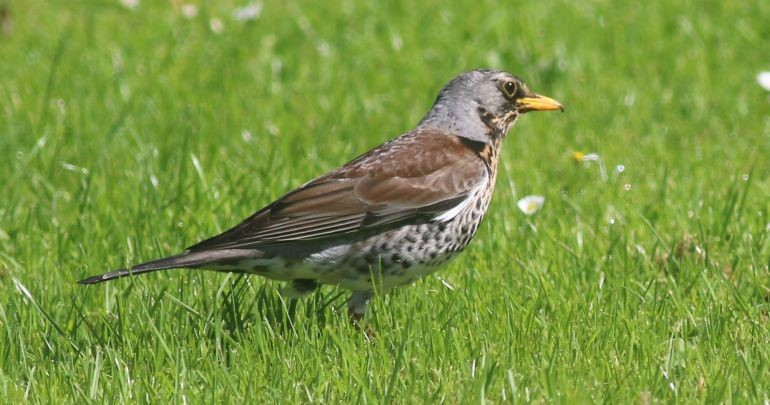
Fieldfare, Kagsmosen. Photo: Frank Desting
Nivå Bugt coastal meadows
East coast of northern Zealand
Staging ducks and waders close to Copenhagen
See Google map with bird observation tower, car park, etc.

Nivå Bugt coastal meadows. Photo: Lise Nielsen
The coastal meadows along the bay of Nivå Bugt are the only locality on the east coast of northern Zealand where there is an open landscape where waders and other waterbirds can stage and forage. Most of the area is coastal meadow, but south of the Nivå stream is a reedbed with several open stretches of water.
In 2008, the Danish Bird Protection Foundation took over management of around 8 ha of the coastal meadow. At that time, the meadow had not been grazed for many years and was therefore overgrown by reedbeds where a few bushes and trees had begun to grow. The meadow was cleared and cattle put out to keep the vegetation down. In 2016 the reserve was expanded and now covers a total of 21 ha. Nearly all the area that was formerly reedbeds is now grazed by cattle from May to October, and has become a coastal meadow with nesting lapwings and skylarks.
Migrating and staging birds:
The coastal meadows are an important staging post all year round for migrating and wintering birds. In spring, waders can be seen, including oystercatcher, knot, curlew sandpiper, dunlin, bar-tailed godwit and common sandpiper. In spring, cranes can be observed on their way to breeding grounds in Sweden. At this period, raptor migration can also be observed. On some days, up to several hundred buzzards can be spotted flying northwards along the coast.
Kestrel can be seen over the meadows throughout the year. Both kestrel, buzzard and sparrowhawk nest in the nearby woods. Sandwich terns, arctic terns and common terns forage along the coast, and eiders congregate further out to sea. In late summer, waders can be seen on their migration south, together with arctic terns and common terns. In autumn, flocks of brent goose, wigeon and lapwing stop over in the area. Large flocks of wood pigeons are often seen on autumn migration.
Great crested grebe, cormorant, whooper swan, canada goose, shelduck, tufted duck and goldeneye frequent the area in winter. On the jetty and the bar, rock pipit can often be spotted. Fieldfares show up in large flocks. The reedbed at the bar is a good foraging site for snipe and jack snipe.
Throughout the year, the bar attracts flocks of cormorants, herring gulls and great black-backed gulls. Kingfisher is seen regularly and small flocks of bearded tit can be spotted over the reedbeds.
The reserve is east of the Strandvej at Nivå between Humlebæk and Rungsted. It is possible to park at the roadside on the Strandvej. There is also a train to Nivå station, from where a 1.5km walk through the park at Nivaagård takes one to Strandvej.
At the reserve there is an information board. A path leads out to a bird observation tower. There is no access to the bar.
West of the reserve is the tileworks of Nivaagaard Teglværk, which is now no longer operating but houses the country’s best-preserved ring kiln, and south-west of this is the art gallery Nivaagaard Malerisamling.
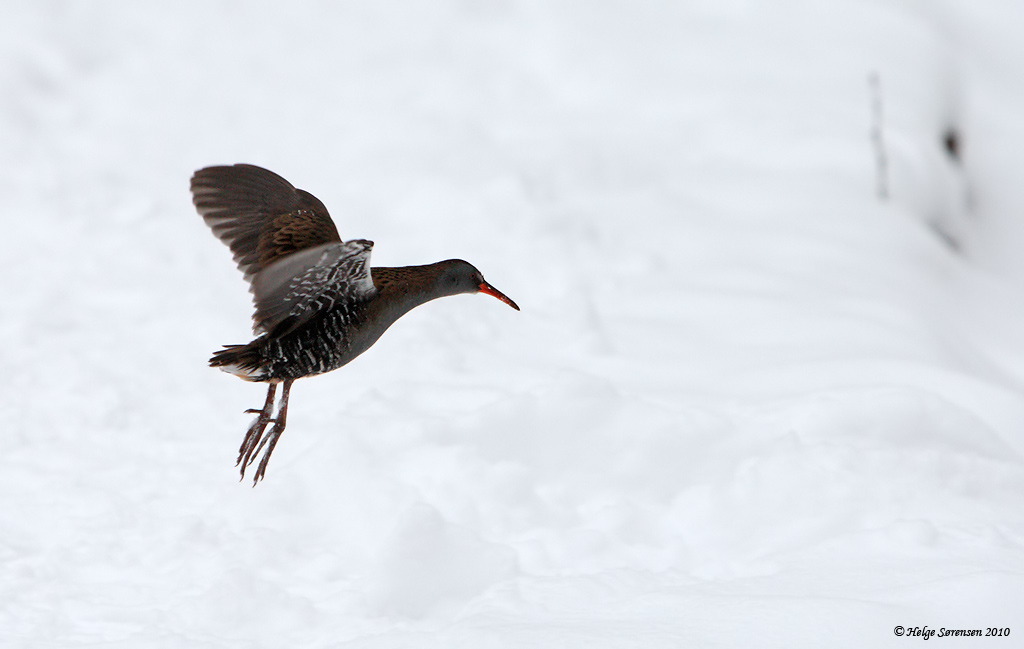
Præstesø
Between Kirke Værløse and the lake of Søndersø, north-west of Copenhagen
A little re-established lake with a surprising variety of bird species
See Google map
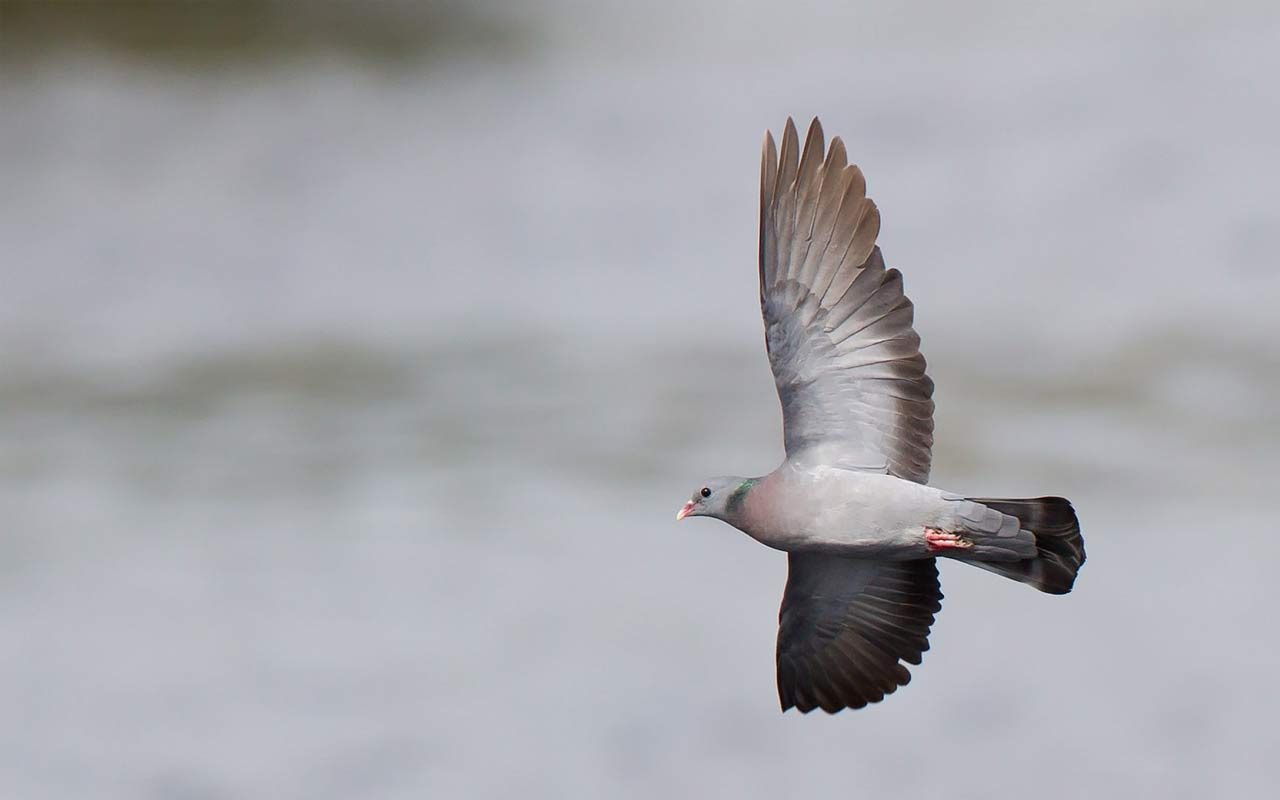
Stock Dove, Præstesø. Photo: Jens Ole Eriksen
Description:
At the beginning of the 1990’s, the area around Præstesø was formed of small patches of open water, large areas of reedbed, rush and sedge, and even larger areas which were drained. To the north were cultivated fields and to the south the land was more or less overgrown. A pump station pumped water from the area into the lake of Søndersø. In 1992 work was started on a nature re-establishment project which entailed raising the water level and introducing grazing around the new lake. In 1996 the pumps were stopped and the 6 ha lake became permanent. A bird observation tower was erected and the whole area was put under preservation orders.
Birds:
Breeding birds:
Thrush nightingale and fieldfare breed in the vegetation to the south of the lake, and many tits and warblers can be seen. The grazed meadows are home to one or two pairs of lapwing.
Stock doves breed near the lake and can be seen daily from April to September. They often come to the lake to rest and drink before flying away. Some days whole families appear together.
Migrating and staging birds:
A notable sight at Præstesø are the many gadwall. They can be seen throughout the year except in June/July and in periods when the lake is covered with ice. The last few years there have been days when up to 100 gadwall have been sighted. Another interesting guest is Caspian tern, which is seen regularly in June/July. Osprey is a regular visitor from July to October, when it can be spotted fishing in the lake and sometimes sitting in the bushes very close to the observation tower. Great white egret and bearded tit are regular guests throughout the year.
During the summer months up to a few hundred non-breeding greylag geese turn up here, using the lake and fields for foraging and moulting. Marsh harrier is a frequent visitor, bittern appears from time to time, and there are many starlings in the season. Other guests are common tern, kingfisher, sedge warbler, spotted flycatcher and red-backed shrike.
In dry summers, the water level in the lake drops a good deal and an island with mudflats appears in the lake. This is adopted by waders during their migration south. They do not usually appear in great numbers, but there are many species. However, lapwings can turn up in flocks of 4-500 individuals.
In autumn, many ducks arrive and teal, wigeon and shoveler can be seen in good numbers, together with the characteristic gadwall. Diving ducks – primarily tufted duck and pochard, but also smew - can be seen in the winter months when the lake is free of ice. However, there is nearly always some open water where mute swan, mallard, coot and the larger gulls, including Caspian gull, collect. There is a good chance of spotting the local white-tailed eagles over the lake. Hawfinch and goldfinch forage in the area.
Sporadic guests such as white-winged black terns have also been spotted at Præstesø up to several times. Rare birds observed here include ferruginous duck (2004), ring-necked duck (2014) and even a Pacific swift in 2013. Over 200 different bird species have now been spotted on this locality.
Visiting and access:The nearest S-train station is at Værløse. From here one can take bus 151 in the direction of Kirke Værløse and get out at Lejrvej, Kildebakken. If you come by car, you can park on the road called “Sandet”. From here there is a walk of about 400 m to reach the bird observation tower at the south of the lake. The present tower was erected in January 2023 and has room for many birdwatchers. There is also a bench where one is sheltered from the wind. From the tower, the whole lake is visible, and the northern area can be viewed with a telescope.
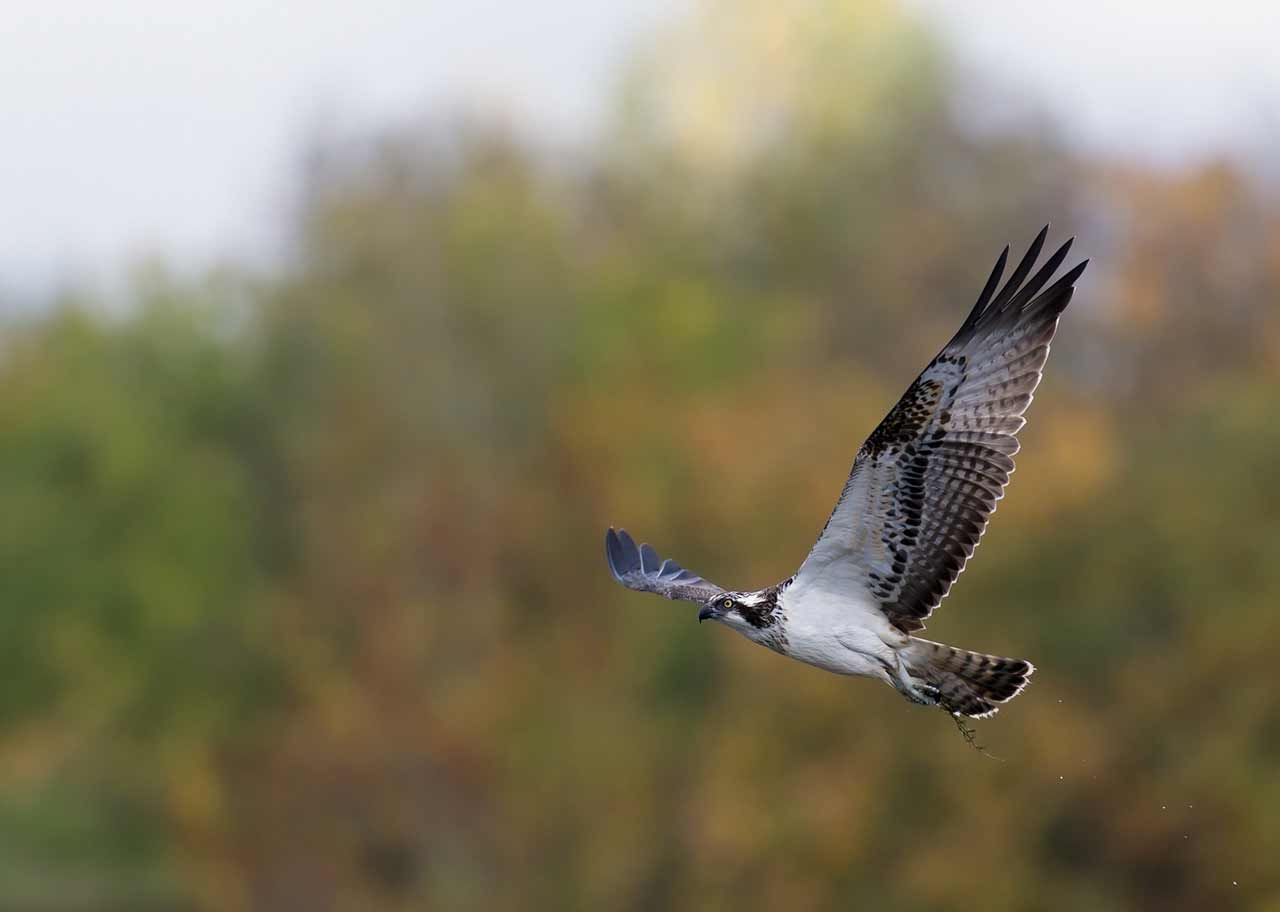
Osprey, Præstesø. Photo: Jens Ole Eriksen
Præstø Fjord and Feddet
South-east Zealand
In the winter months, this area is an important staging post for swans and many other waterbirds and for many overwintering raptors. Feddet is also a good outlook point for observing spring and autumn migration.
See Google-map for car park, bird observation tower, etc.
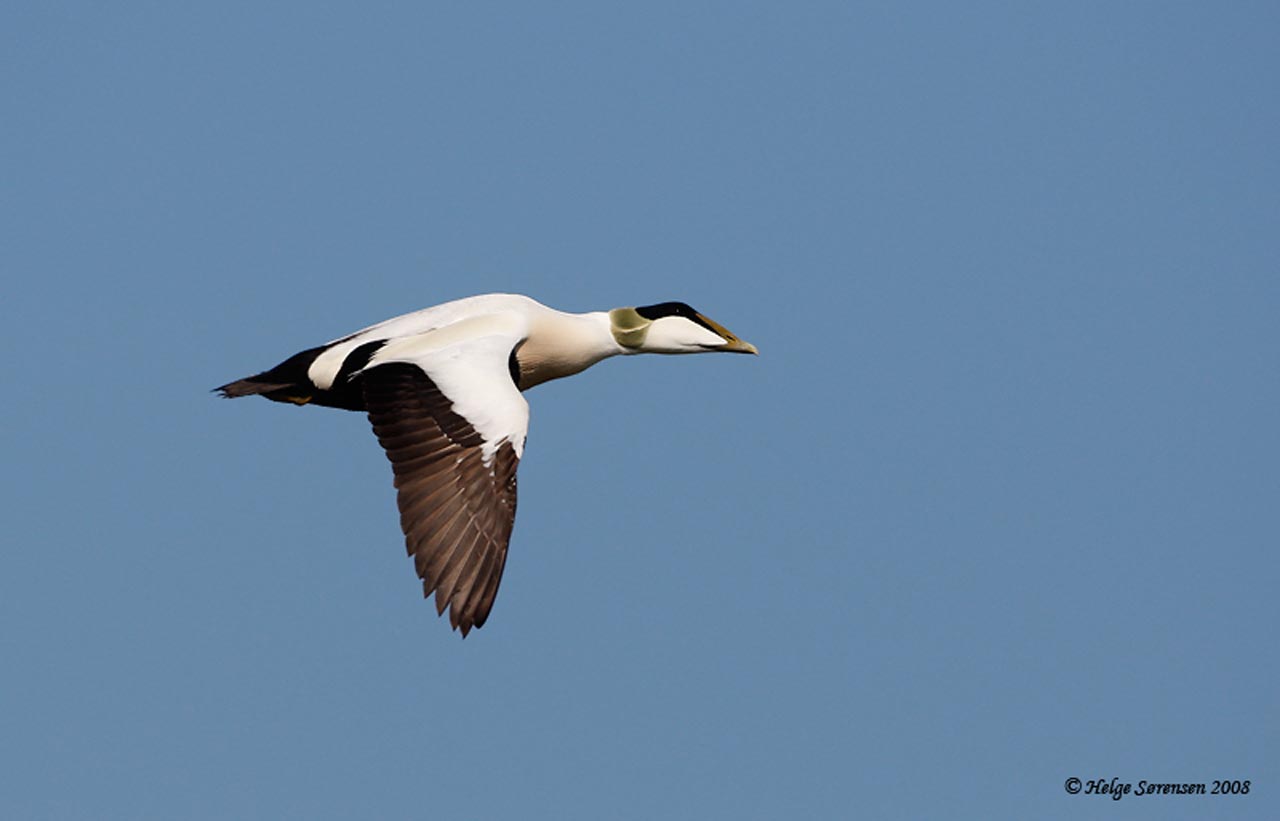
Eider. Photo: Helge Sørensen
Description:
Feddet is a long peninsula dividing Præstø Fjord from the bay of Fakse Bugt. The peninsula consists of flintstone, sand and gravel, which has been eroded away from Stevns Klint to the north, transported along the coast by sea currents and deposited as beach ridges. On the eastern side of the peninsula a new beach ridge, Fedhagen, is becoming established. Feddet is partly covered with woodland, especially spruce and pine, but also birch and larch. A broad sandy beach along the whole of the eastern side is popular in summer. The south-easterly section is heath, which is a rare form of landscape in eastern Denmark. To the south, the peninsula is rounded off by coastal meadows and reedbeds, whilst the south-western section is cultivated land.
Præstø Fjord has brackish water. Only a small gap to the south connects the fjord with the bay of Fakse Bugt. Most of the fjord is over two metres deep, but south of Feddet the water is shallow. Here there are some low islands with coastal meadows: Lilleholm and Storeholm to the south-west of Feddet and Maderne to the south-east. A project has started to restore, develop and improve nature on the former farmland in the southernmost section of Feddet.
Birds:
Breeding birds:
The usual species of passerine nest in the woodland. Firecrest can be heard regularly. Stonechat breeds in the open areas.
A few species of wader breed on Feddet, including lapwing, redshank and ringed plover. A few pairs of goosander breed in nesting boxes.
Migrating and staging birds:
Feddet is a good location for watching migrating birds. Many raptors are seen, both spring and autumn. Many species are represented, including honey buzzard, red kite, black kite, rough-legged buzzard, a few osprey and several species of falcon. Pallid harrier is seen migrating every year now, often both spring and autumn. Migrating geese are seen in good numbers, especially barnacle goose (in tens of thousands) and dark-bellied brent goose. Some years, large numbers of crane fly over the area in spring – in autumn their numbers are limited. Large flocks of wood pigeon mixed with a number of stock dove migrate over the area in autumn.
In autumn, too, arctic skua and - in good years - pomarine skua and long-tailed skua can be seen off the coast (although nearly only when the wind is blowing from the east), together with good numbers of little gull.
The area is a staging post for many waders, and on good days in late summer and autumn 15-20 different species can be spotted. Many terns stage here too, including rare species such as caspian tern and black tern.
Feddet is an important staging post for ducks. The largest flocks appear in autumn and winter. Both dabbling ducks such as widgeon, teal and mallard, and diving ducks such as tufted duck, scaup, eider, goldeneye and red-breasted merganser are the most numerous species. Small flocks of long-tailed duck and smew are also seen. The birds can be spotted off the south-easterly point especially, but large flocks can also be seen further out to sea. Divers can be seen flying past or in flocks on the water, and great crested grebe and often Scandinavian grebe stage here.
In autumn and winter, Feddet, Maderne and the fjord offer shelter for geese and swans, including white-fronted goose, greylag goose and large flocks of barnacle goose and mute swans in their thousands and smaller flocks of whooper swan. The geese feed on the coastal meadows and on the fields in the south-western section of Feddet especially, or they gather on the Præstø Fjord. Large flocks of coot – sometimes thousands of birds – can often be seen.
Several species of raptor forage over the coastal meadows and fields on Feddet. Sparrowhawk, buzzard and kestrel can be seen throughout the year, and in winter hen harrier and rough-legged buzzard appear. White-tailed eagle is seen all year round and peregrine is a regular guest.
In the woods on Feddet, the usual woodland birds can be found. In winter one can sometimes find both crossbeak and parrot crossbeak in the wood. Great grey shrike is often spotted on the heathland and sometimes twite, shore lark and snow bunting along the coast.
Now and again rarities are spotted. During the last few years there have been several observations of red-breasted goose and black stork. The most unusual species seen recently have been spotted eagle (2020), bee-eater and grey phalarope (2021), Blyth's reed warbler (2022) and white-billed diver and lesser spotted eagle (2023).
Visiting and access:
Feddet is privately-owned property belonging to the Strandegård estate, but it is permitted to walk along the coast, on the areas that are not enclosed, and on the paths through the woodland.
From route 209 between Fakse and Præstø, turn along Lindersvoldvej. 3km further on, turn right onto Fedvej, and after a few kilometers you will arrive at a camp site. Here it is possible to use the pay car park. From here, one can walk south along the coast or through the wood.
There is a bird observation tower at the southern end of the peninsula on the border between the cultivated land and the wood. From here there is a good view across the fields and the meadows to the south, where a recent project aims at re-establishing the natural hydrology.
North of Feddet is the protected deer park Strandegård Dyrehave with old oak trees and beech trees, that is also worth a visit.
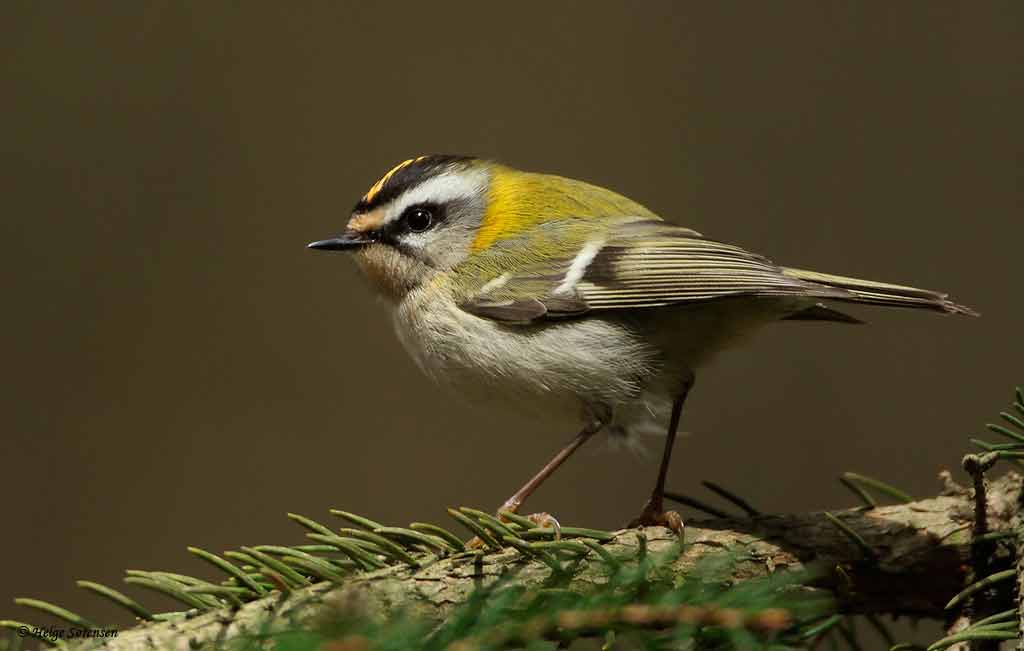
Firecrest. Photo: Helge Sørensen
Ravnstrup Sø
Southern Zealand, south-east of Glumsø
Birdsong in springtime.
See Google map with bird observation towers, car park, etc.

Description:
Ravnstrup Sø is a nutrient-rich lake surrounded by reedbeds, meadow, willow scrub and old deciduous woodland, in the middle of intensively cultivated farmland. Since the Danish Bird Protection Foundation acquired the area in 1983, it has been re-established as a nature area: the level of the water in the lake has been raised and a large area with reedbeds and willow scrub has been cleared.
Birds:
Breeding birds:
A large number of passerines nest at Ravnstrup Sø, including wren, robin, thrush nightingale, song thrush, marsh warbler, reed warbler and reed bunting. Birdsong reaches its peak in the morning and evenings in May/June. Red-necked grebe, mute swan, greylag goose, water rail and coot nest around the lake, and now and again marsh harrier. The small woods on the western bank of the lake are home to tawny owl, jackdaw and sometimes stock dove.
Kingfisher can be seen throughout the year and nesting boxes have now been erected in the hope that this will make it easier for the kingfisher to breed here. It is also hoped that bittern will establish itself in the reedbeds – it has been seen and heard during the last few years but has probably not yet bred here.
Migrating and staging birds:
At the end of summer, the area is relatively quiet, but in autumn, flocks of fieldfare and redwing turn up, visiting the berry bushes and the old apple trees in the area, and roosting for the night in the willow scrub. Osprey is also a regular guest. In winter, a few tufted duck and now and again goldeneye and goosander can be seen. Buzzard is regular throughout the winter. In February, the locality is often visited by different species of geese in quite appreciable numbers (several hundreds).
Visiting and access:
From route 14 between Næstved and Ringsted, turn off towards Glumsø at the Herlufmaglehallen. After about 2km (the second road after the railway bridge) turn left along Ålehusvej towards Trælløse/Skelby. The entrance to the car park is at the first turning in the road.
From the car park there is a 1.5km long path along the western boundary of the reserve. This leads to a bird observation tower and a hide right down by the lakeside. From both places there is a view of the lake and the reedbeds. The reserve has a shelter that can be used day and night, a nature centre and a toilet. There are also two bonfire sites.

Wren. Photo: Albert Steen-Hansen
The Rørvig peninsula
North-west Zealand, between the Isefjord and the Kattegat, near the town of Nykøbing
An impressive spring migration of passerines and raptors at Korshage. Breeding and staging waterbirds at Hovvig.
See Google map with look-out points, bird observation towers, car parks, etc.

Description:
The Rørvig peninsula has an attractive and varied landscape and consists of rolling fields, heath, dry meadows and plantations, with some small lakes and patches of wetland. The marine foreland is dominated by beach ridges. At the end of the stone age, 6000 years ago, the sea level was more than 4m above the present level and the area was divided into a number of islands. Since then, the land has risen and the areas between the islands have become dry land. This former seabed has now been taken over by large agglomerations of holiday bungalows, with the plantation known as Rørvig Sandflugtsplantage to the north. The plantation was established in the mid-19th century to stop the shifting sands, which had been a problem here since the 16th century.
Between Nykøbing and Nakke is Hovvig, which is a large wetland area surrounded by reedbeds, meadows and small woodlands. Hovvig was cut off from the Isefjord by a dyke around 1870 and it was intended to drain the area for cultivation. However, the dyke was burst by a storm in 1902 and Hovvig was flooded. The dyke was rebuilt, but drainage was discontinued and the area was used for hunting, fishing, reed harvesting and grazing. It is now a nature reserve and a good birding spot. East of Hovvig, the area known as Slettemose has been re-established to create an open landscape.
Birds:
Breeding birds:
Stonechat and red-backed shrike breed on the open areas at Korshage.
Hovvig is a good breeding site for waterbirds. Breeding birds include little grebe, great crested grebe, mute swan, greylag goose, shelduck, mallard, shoveler, pochard and tufted duck. In addition, there are breeding water rail, coot, lapwing and snipe. Thrush nightingale, sedge warbler and reed warbler nest in the thickets and reedbeds. Bluethroat bred here for the first time in 2023. Bearded tit and penduline tit have bred here with a few pairs. There is a fair-sized cormorant colony in the trees at the north-western boundary of the reserve.
Migrating and staging birds:
Korshage is best known for its spring migration, especially with winds from the west and north-west. However, in autumn there is a chance of seeing many species of seabirds which are driven into the Kattegat during the autumn storms, for example fulmar, shearwaters, gannets, skuas and auks.
A large number of different bird species fly out over Korshage on spring migration. Many raptors are seen, for example honey buzzard, red kite, white-tailed eagle, marsh harrier, hen harrier, goshawk, sparrowhawk, buzzard, rough-legged buzzard, osprey, kestrel, merlin and hobby. Cranes also pass overhead. Nearly 1000 have been seen on a single day. Some bird species migrate in enormous concentrations, for example pigeons: numbers of up to 15,000 wood pigeons per day are not unusual. Some stock doves can be seen in the flocks. Crows and thrushes are also seen in large numbers, and chaffinches and bramblings can form large flocks. Other migrating birds include short-eared owl, different species of pipits, yellow wagtail and ring ouzel. Wryneck can be spotted staging here under migration. Along the coast, geese and various dabbling ducks and diving ducks fly past.
Hovvig is an important staging area for many ducks and waders. Among the various species of dabbling and diving ducks seen here, goldeneye and scaup deserve special mention, as these species can appear in large numbers. Smew, red-breasted merganser and goosander are seen regularly, as are mute swan, whooper swan, white-fronted goose, greylag goose and canada goose. Several species of raptors stage in the area around Hovvig. Osprey is seen regularly on migration at Hovvig and Korshage. A pair of white-tailed eagle breed in the vicinity and show up daily at Hovvig. Hen harrier forages here in the winter months. In winter, too, great grey shrike can often be spotted in the surrounding thickets.
Rørvig Fuglestation, which is a local organization, has a website with daily updates of observations and other information. The website can be downloaded here.
Visiting and access:
The Rørvig peninsula can be reached from the town of Nykøbing on Zealand. Korshage can be reached by driving to the village of Rørvig and following signs to Korshage (driving along Nørrevangsvej and Korshagevej). After nearly 4½km, where the road bends sharply, there is a car-park, from where one can walk along the coast out to the tip of the peninsula. The best observation spot is around 2-300m south of the tip.
To reach Hovvig, one can turn south from the Nykøbing-Rørvig road in the direction of Nakke. At the T-junction in Nakke, one turns first right and then left and continues southwards along Nakke Vestvej. After nearly 1km, Hovvigvej turns off right. At the end of the road is a small car-park. From here one can continue on foot to reach Hovvig. Just inside the reserve boundary is a large bird observation tower with a view over the whole reserve. A little further on along the embankment is an old boathouse that has been fitted out with picnic tables.
The Nature Agency has published a miniguide with map about Hov Vig, which can be downloaded here, and a folder with a map about the Rørvig Sandflugtsplantage, which can be downloaded here.
Hovvig is a nature reserve with certain restrictions concerning access. It is not permitted to go out onto the meadows, the reedbeds or the outer dyke. However, one can get quite close to the birds from the road crossing the reserve and there are good views from both observation towers.

Stonechat. Photo: Jørgen Scheel
Selsø Sø
Hornsherred, Zealand
One of Zealand’s lakes with the most abundant birdlife
See Google map with car-parks etc.
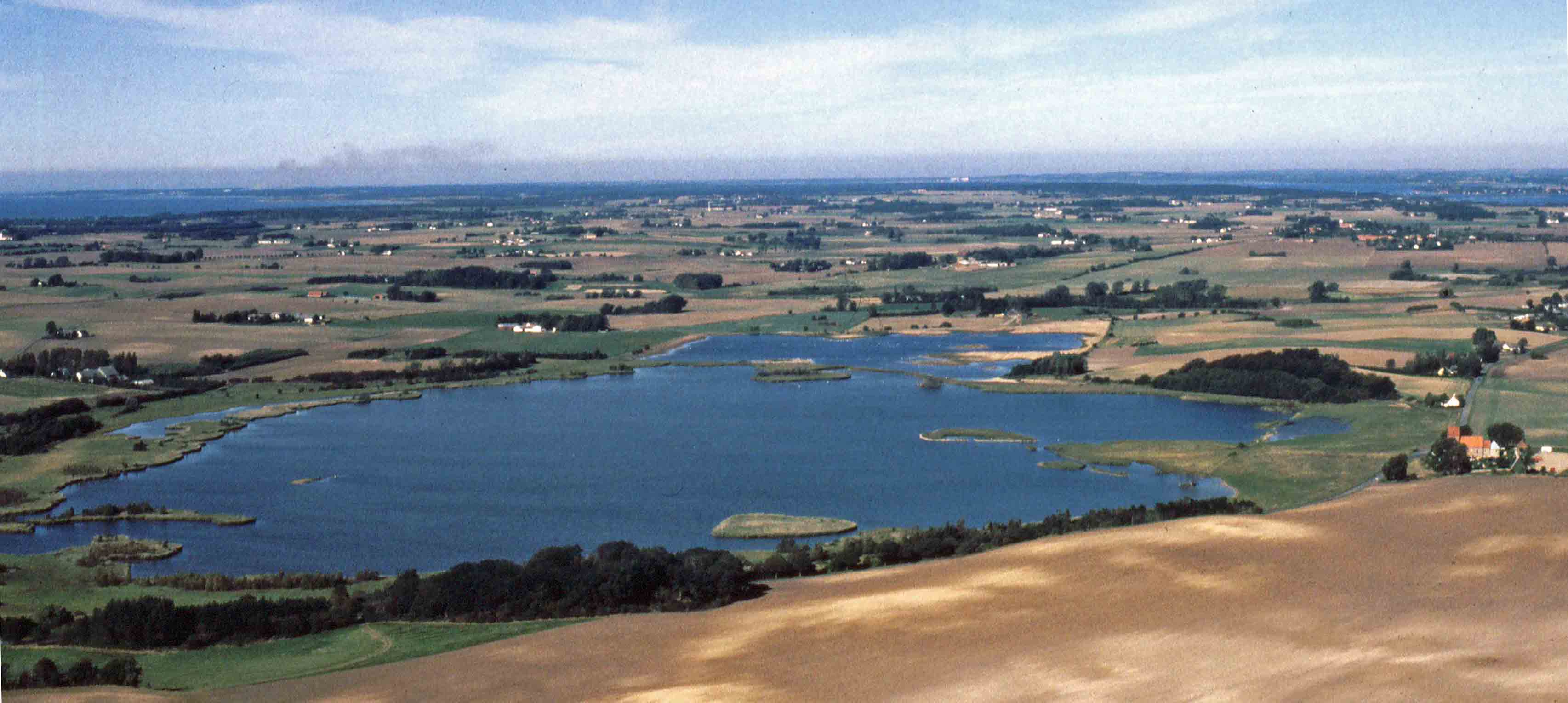
Selsø Sø. Photo: Pelle Andersen-Harild
Description:
The lake of Selsø Sø is around 12km south of Frederikssund and was originally a shallow stretch of Roskilde Fjord. In the 17th century, an embankment was built across the fjord, creating Selsø Sø. In the 19th century attempts were made to drain the lake with a view to cultivating the land, but the projects failed and the area became partly overgrown with reedbeds. In 1967 the northernmost part of the lake was cut off by an embankment and the area was drained by pumping, but 30 years later the area was re-established. Today Selsø Sø is a shallow lake surrounded by reed bogs and meadows grazed by cattle. It covers an area of around 90ha and has a maximum depth of 2m. The lake and its surrounds are preserved and access is forbidden.
Birds:
Breeding birds:
The area houses red-necked grebe and great crested grebe, mute swan, greylag goose and a good many species of duck, namely shelduck, gadwall, mallard, shoveler, garganey, pochard and tufted duck. In addition, coot, moorhen and water rail breed. There is a colony of black-headed gulls numbering around 600 pairs and around 20 pairs of avocets. A colony of common terns has unfortunately disappeared. Mediterranean gull has been seen in the summer months but does not breed here.
Around 400 pairs of cormorant breed at the lake – partly in colonies on the eastern side of the lake, and partly in small groups in trees around the lake. On the meadows bordering the lake, lapwing, ringed plover, snipe and redshank can be seen. A pair of marsh harrier breed at the lake.
Other breeding birds include cuckoo, yellow wagtail, thrush nightingale, sedge warbler, marsh warbler, reed warbler, bearded tit and reed bunting.
Migrating and staging birds:
Outside the breeding season, birdlife is still abundant. Ducks, especially, appear in large numbers throughout the year. Mallard gather in flocks of thousands, but there are also many wigeon, gadwall, teal, shoveler, pochard and goldeneye, sometimes in hundreds. Great crested grebe, cormorant, grey heron, mute swan and coot can also be seen.
In the winter many thousands of tufted duck stage on the lake during the daytime. Around an hour after sunset they fly out to Roskilde Fjord to forage, returning to the lake an hour before sunrise.
Selsø Sø is an important moulting locality for greylag geese. In May-June they lose their flight feathers and cannot fly for several weeks. There are greylag geese on the lake all year round. In summer and up to mid-September there are mostly geese from eastern Denmark. Later, geese from Sweden and Norway turn up. Up to a few thousand can be seen on the lake and the surrounding fields. Since the beginning of the 2010's, barnacle geese have been showing up in larger and larger flocks, and white-fronted geese have also started to appear in their hundreds in the spring.
Many waders can be seen, especially in late summer and at the beginning of autumn. Lapwing is the most frequent visitor, but wood sandpiper, ruff, common sandpiper, spotted redshank and greenshank are also numerous.
In winter, whooper swan can be seen, and smew and goosander if the lake is free of ice.
White-tailed eagles are seen regularly – mostly the pair that nests in the vicinity. Osprey appears during migration in April and August-September. Red kite and peregrine falcon are seen regularly. In autumn there can be a good raptor migration if there are easterly winds.
Visiting and access:
If using public transport, take the S-train to Frederikssund station and then the number 318 bus to Selsø. Get off at the "Selsø Kirke" bus stop (ask the busdriver if necessary). Buses are unfortunately infrequent, so consult the timetable first.
If coming by car, turn off onto Selsøvej towards Sønderby at the roundabout in Skibby. After 1.7km one reaches a T-junction in Mandrup and the lake comes into view. The lake and meadows can be viewed from the road leading round the lake, but there are several places where one can park and enjoy a fine view of the lake.
By driving northwards from the T-junction in Manderup one reaches Ventevej on the right-hand side. Drive down this road and when it turns left, carry on straight ahead along a dirt track which leads to a car park to the north of the lake. From here there is a good view of the area that cannot be seen from the bird observation tower.
From the T-junction, one can also turn south to reach a car park at the southern end of the lake at Møllekrog. From the car park, walk a few hundred metres east along the road to reach a footpath on the left-hand side of the road. The path leads to a bird observation tower with a good view over most of the lake. By continuing along the road one reaches Selsø church, where one can park and view the lake from the hill just north of the church.
Other sights:
From the car park at Møllekrog there is a fine view over Roskilde Fjord. A path leads along the fjord to Skrivernæbbet. From here, one can see large flocks of goldeneye, coot and mute swan in winter. The manor house of Selsø Slot is just east of the lake and is open in the summer months.
From Møllekrog a path leads to Selsø church. The path offers a fine view over the lake of Bredvig Sø, which has been newly re-established. It is a fresh water lake with good potentialities for birdlife - but there may be some hunting activities.
Selsø church was originally a round church. Its present appearance dates from around 1100 AD. On the field north of the church and just east of Teglværksvej, an archaeological excavation carried out in 1994 revealed a large number of pit houses built between 700-1000 AD. It is believed that the locality was a natural harbour where viking ships could lay at anchor, when they were not needed elsewhere. In Selsø they were sheltered and well hidden.
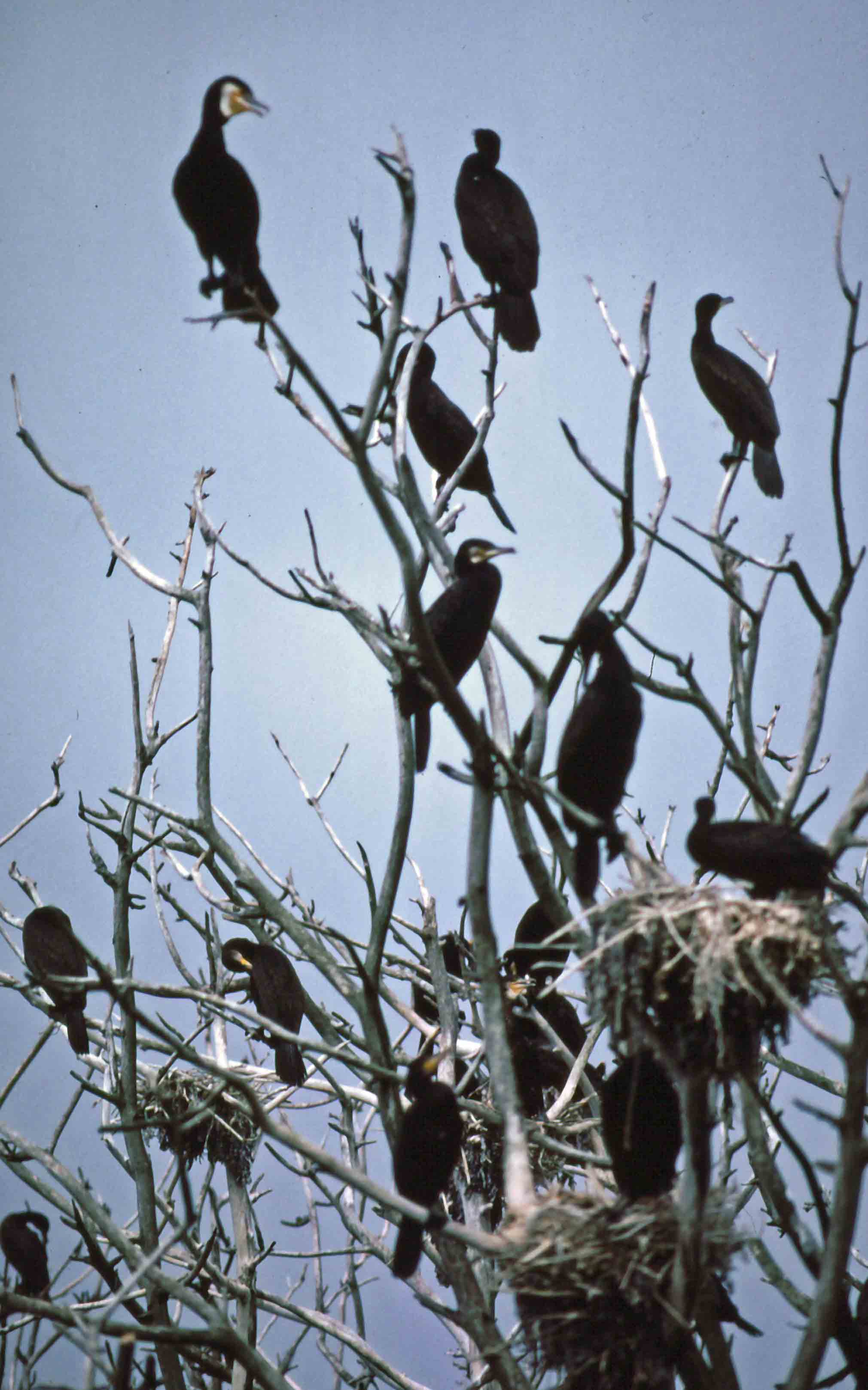
Cormorant colony. Photo: Pelle Andersen-Harild
Smør- and Fedtmosen
North-west of Copenhagen near Herlev/Gladsaxe
Many breeding and migrating birds in an area with small lakes, fields and meadows..
See Google map with car parks, bird observation tower, etc.

Smørmosen and Fedtmosen. Photo: Frank Desting
Description:
The area comprising the two bogs Smørmosen and Fedtmosen and the adjacent meadows covers around 150 ha. with bogs, small lakes, open woodland, scrub, reedbeds and meadows. The fields around Kildegården are used for organic farming and are grazed by cattle. The stream of Tibberup Å flows through the area.
The two bogs originate from springs on one of the slopes in the subglacial stream trench in which the area lies. The lakes in the area are originally a result of peat-digging during both world wars, and have since been enlarged. During the last few years, nature management has been carried out, for example by clearing the overgrown areas.
Birds:
There is a varied flora and fauna in the area. Around 200 different bird species have been registered, around 50 of them breeding here each year.
Breeding birds:
Breeding birds include red-breasted grebe, little grebe, several species of duck, water rail, moorhen and coot and – not least – many warblers, in addition to sparrowhawk, buzzard, marsh harrier and kestrel. Other breeding birds include lapwing, jay, cuckoo, skylark, great spotted woodpecker, marsh tit, long-tailed tit, treecreeper, goldfinch, bullfinch and hawfinch. At one time, the area housed a large colony of fieldfare – probably the second largest in the country – but this has declined in the last few years and there are now only a few pairs left. Tawny owl, penduline tit, spotted flycatcher and pied flycatcher breed here sporadically.
Migrating and staging birds:
Spring and autumn bring a considerable number of migrating birds that fly over the area or settle here for a short while. Quite a number of raptors, such as buzzards, honey buzzards and sparrowhawks, are seen every year, together with lesser numbers of red kite, goshawk, rough-legged buzzard, osprey, hen harrier, marsh harrier, hobby and merlin. With luck one can spot a peregrine. Even rare birds such as golden eagle, lesser spotted eagle and white-tailed eagle have been observed very occasionally over the area.
Cranes fly overhead on migration every year, usually in the springtime. If the wind is blowing from the east, the flocks can be very large. Many different species of passerines can be seen on migration. Around Kildegården a considerable number of pipits, yellow wagtails, larks, hirundines, thrushes, wheatears and whinchats can be seen, together with several thousand finches. The migration can best be seen from Klausdal (in the south-eastern part of the area) or around Kildegården. There are always a good number of passerines that stop over in the bogs.
In winter, one or two goshawks can be seen every year, in addition to the 3-6 stationary buzzards, and sometimes rough-legged buzzard and hen harrier. Some years, overwintering bittern can be spotted. Occasionally there are invasions of fieldfare, redwing and waxwing and of many passerines, including colourful finches. On the edge of the north-west corner of Fedtmose is a site where long-eared owls overwinter. In 2010 they also began to breed here.
Visiting and access:
Using public transport, the easiest way to reach the area is to take bus 165 which goes between Herlev Station and Gladsaxe Trafikplads (get off at Værebrovej), or the lokal Herlev buses 167/168 (get off at Peberhaven).
If you come by car, you can park at the Kildegården Nature Centre, from where there is easy access to the area. At the centre you can find brochures and maps about the area. It is also possible to park at Klausdal or on Gråpilevej.
A network of paths leads round the area, some of them forming part of a walking trail between Kalvebod and Værløse. There is a bird observation tower in Smørmosen.
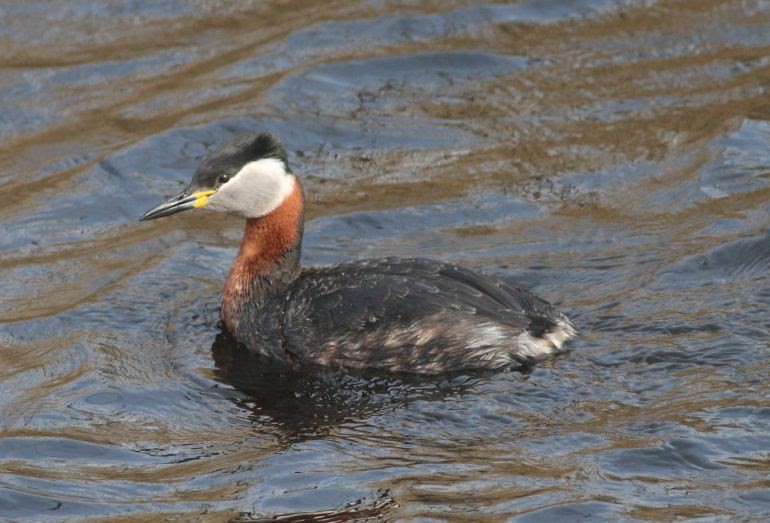
Red-necked grebe, Smørmosen. Photo: Frank Desting
Stevns Klint
East coast of southern Zealand
Zealand’s best locality for raptor migration in autumn
See Google map with look-out points, car parks, etc.

The lighthouse at Stevns Klint
Description:
Stevns Klint is a long chalk cliff on south-east Zealand - 20 km long and up to 40 m high - stretching from Holtug in the north to Rødvig in the south. Along most of the stretch, farmland reaches right out to the cliff, mostly with bushes and scrub along its edge, or trees where there are buildings. There are abandoned chalk quarries at Holtug and Boesdal, and an active chalk quarry – Stevns Kridtbrud – situated at Mandehoved.
Stevns Klint is a UNESCO World Heritage Site. The cliff harbours a record of the cloud of ash formed when the Chicxulub meteorite crashed into the Earth about 65 million years ago, causing mass extinction of over 50% of life on the planet.
Birds:
Breeding birds:
Stevns Klint is well known as one of the few sites in Denmark where there are breeding peregrines. They have nested here since 2008. There are now 4 pairs spread out along the cliff. Between 1 and 4 chicks are successfully reared every year.
House martins and sand martins also breed along the cliffs.
Migrating and staging birds:
Stevns Klint is only 25 km from Falsterbo at the southermost point of Sweden, where autumn migration is impressive. Many of the migrating birds find their way to the Danish coast at Stevns, which makes it a hotspot for watching autumn migration. Raptor migration is especially thrilling and a large number of birds are seen. Honey buzzard, buzzard and sparrowhawk can appear in large numbers. Fair numbers of red kite, marsh harrier, hen harrier, rough-legged buzzard, osprey, kestrel and merlin are spotted. Species that turn up each year, but only in small numbers, are black kite, white-tailed eagle, pallid harrier, Montagu’s harrier, goshawk, hobby and peregrine.
Very rare guests that turn up infrequently are black-shouldered kite, short-toed eagle, long-legged buzzard, spotted eagle, lesser spotted eagle, steppe eagle, imperial eagle, golden eagle, booted eagle, Eleonora’s falcon, red-footed falcon and gyr falcon.
Visiting and access:
The area can be accessed by several minor roads leading east off routes 261 or 154 or the town of Store Heddinge. A path follows the top of the cliff from Bøgeskovhavn in the north to Rødvighavn in the south. There are seven places where one can come out to the coast:
1) Bøgeskov Harbour. Here there is a car park and a view along the cliff from the beach or the harbour jetty.
2) Holtug Kridtbrud (in the north) is a chalk quarry that is now abandoned. There are a few interesting dunes and water-holes. Several rare chalky soil plants thrive here. In early summer the water-holes teem with thousands of common newt (Triturus vulgaris). To get here, drive from Holtug towards the coast along Holtug Linievej and follow signs to Holtug Kridtbrud.
3) Mandehoved / Flagbanken is the best site for watching raptors on autumn migration. Patches of woodland and hedgerows here attract passerines. There are excellent views out over the sea towards Falsterbo from the cliff near the nature centre.
4) Stevns Kridtbrud is a working chalk quarry south of Mandehoved. It can be viewed from the road (Hærvejen) west of the quarry or from Mandehoved (follow the path going south from Flagbanken). In 1996, a black-eared wheatear staged here all summer. Black redstart breeds yearly.
5) Stevns lighthouse is surrounded by wood and hedgerows providing suitable breeding and staging sites for passerines. Scarlet rosefinch has bred here previously and can possibly still be seen. Several rather rare warblers have been spotted here in the past: dusky warbler, Hume's yellow-browed warbler, Pallas's warbler and yellow-browed warbler. In a few places there are fair views out over the sea. To get here, drive northwards on Hærvejen from the village of Højerup. After 2 km, turn right for the lighthouse.
6) Højerup is a popular target for tourists. Serins are seen here now and again. Firecrest is spotted regularly, and in past years many rare passerines such as citrine wagtail, Siberian stonechat, red-breasted flycatcher, collared flycatcher, Pallas's warbler and yellow-browed warbler have been seen. This outlook spot is a good place to watch raptor migration, especially in north-westerly winds. From the car park it is possible to walk to the cliffs and down to the beach on some steps which start near the church. One can follow a path northwards through the little wood of Højeruplund to the look-out point called Bråten, where there is a splendid view of the cliff with the old church perched right on the edge.
7) Boesdal Kalkbrud and Korsnæb is an abandoned chalk quarry, situated between Højerup and Rødvig. There is a car park at the entrance to the quarry. There are good possibilities of seeing wheatear here.

Sparrowhawk. Photo: Albert Steen-Hansen
Stigsnæs
The most south-westerly point of Zealand, south-west of Skælskør
One of Denmark’s best localities for autumn migration of raptors. The best locality on Zealand for autumn migration of pigeons and passerines
See Google map with car parks, etc.

Young honey buzzard. Photo: Helge Sørensen
Description:
Stigsnæs is a promontory mostly covered by deciduous woodland. Along its northern border there is a small area of reedbed and coastal meadows. There is a narrow beach along the coast.
Migrating and staging birds:
The area around Stigsnæs is of international importance as a migration locality. Migration can be watched from the middle of August onwards, and does not ebb out until the beginning of November. The biggest numbers of migrating birds are seen in south-easterly winds.
Passerines start migrating as early as mid-August. Yellow wagtails and tree pipits are the first to show up, and later on come chaffinches and bramblings (sometimes in large flocks), meadow pipits, thrushes, tits, starlings, crossbills and reed buntings. In October and November, large flocks of pigeons fly over the area. Crows, rooks and jackdaws also migrate in large flocks, sometimes with several thousand birds on one day.
Brent geese and barnacle geese can be seen flying off the coast.
Stigsnæs can offer one of the largest migration of raptors in Denmark. Honey buzzard is the first raptor to head south. This happens at the end of August, when marsh harrier, osprey and several species of falcon also start to migrate. In September and October it is the turn of red kite, marsh harrier, hen harrier, goshawk, sparrowhawk, buzzard, kestrel and merlin. Now and again, white-tailed eagle, red-footed falcon, hobby and peregrine are spotted. Sometimes rarities show up - in 2018, for example, pallid harrier and red-breasted flycatcher.
White-tailed eagle and peregrine can be seen all year round, as they both breed in the vicinity.
Visiting and access:
From Skelskør, follow signs to Stigsnæs. It is possible to park at the ferry harbour, where there is a large car park. From here one can follow a path northwards along the beach, from where one can observe the migration. The best spot from which to observe the raptor migration is the end of the southern mole at the harbour.

Hen harrier. Photo: Helge Sørensen
Store Hareskov
North-west of Copenhagen between Bagsværd, Ballerup and Værløse
Forest with varied nature and birdlife close to the city suburbs
See Google-map with car parks etc.
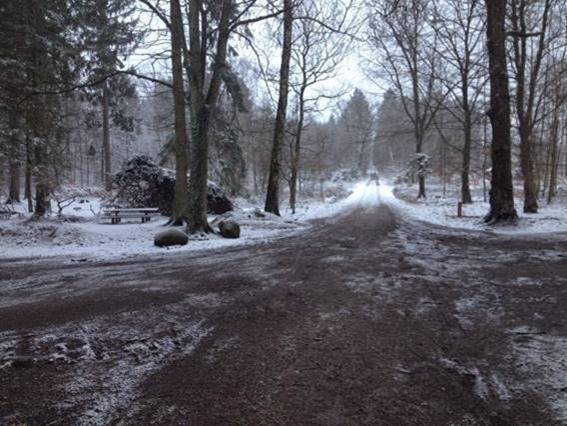
Store Hareskov. Photo: Frank Desting
Description:
Store Hareskov is the easternmost part of a large, state-owned forest district north-west of Copenhagen called Hareskovene. Most of the area is classic, tall-stemmed beech forest, but there are also some parts with spruce. The forest floor is mostly poor in vegetation, but in some parts where draining has been stopped small lakes and bogs with interesting flora and fauna have appeared.
The Fægyden road between Hareskovby and Værløse, which was formerly used for driving livestock, divides the forest area into Lille Hareskov (to the west) and Store Hareskov (to the east). In Store Hareskov there are straight paths radiating in the form of a star and bearing witness to the hunting activities of former kings. Now, the forest is managed with emphasis on recreational values. There are several open bonfire sites in both forests, and an overnight shelter in Lille Hareskov.
At the southern edge of Store Hareskov is a rampart known as Svenske Vold (“Swedish Rampart”). This was the site of one of the Swedish army’s many camps during the war between Denmark and Sweden in 1658-60 and the siege of Copenhagen. The rampart is around 400 m long and has a parallel ditch.
Birds:
Breeding birds:
Some of the breeding birds registered in the past few years include little grebe, greylag goose, goshawk, buzzard, tawny owl, woodcock, stock dove, black woodpecker (2018) and great spotted woodpecker. Smaller birds include common woodland birds together with pied wagtail, redstart, goldcrest, firecrest, spotted flycatcher, long-tailed tit, marsh tit, coal tit, nuthatch, treecreeper, jay, dunnock, red-backed shrike, goldfinch and bullfinch.
Migrating and staging birds:
Migrating birds can be observed from Store Hareskov, for example several species of wildfowl (including geese and swans) and various raptors – now and again white-tailed eagle. Cranes and many passerines also pass over the forest. White stork has been seen flying over a few times in recent years.
In winter, one can find common woodland birds. Two-barred crossbill has sometimes been spotted when there has been an invasion. Now and again great grey shrike has been a guest.
The forest has become famous with birdwatchers and photographers due to the appearance in certain winters of a stationary hawk owl, which has attracted a lot of attention. The rare pigmy owl has also been seen one year.
Black woodpecker and little spotted woodpecker have been seen now and again throughout the year.
Visiting and access:
The S-train (and bus 165) go directly to Hareskov Station from Copenhagen. There is room for parking here if you come by car. From the station there is easy access to the forest. Another possibility is to use the entrance to the forest at Skovbrynet Station. There are several other car parks in the vicinity.
It is a good idea to use the Nature Agency’s folder with map, which can be downloaded here.
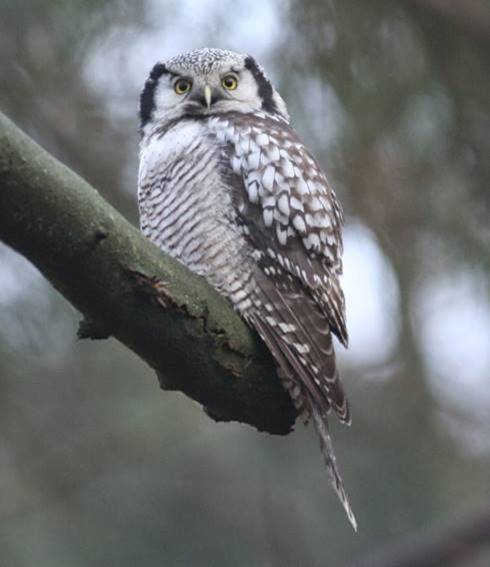
Hawk Owl, Store Hareskov. Photo: Frank Desting
Sømosen
West of Copenhagen between Ballerup and Herlev
Area of bog, islands and islets and a rich birdlife in the middle of the suburbs
See Google map with bird observation tower, etc.
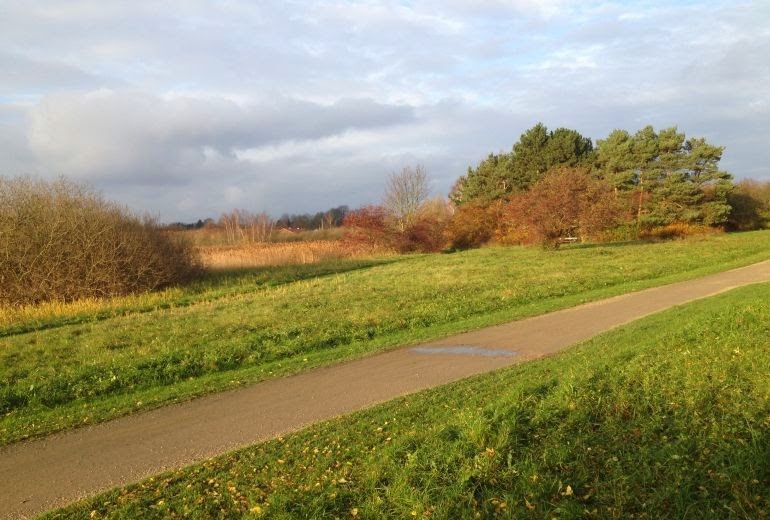
Sømosen. Photo: Frank Desting
Description:
Sømosen is situated west of the suburb of Herlev, next to Lautrupparken. The green area, of which one third is a park with grass and scattered bushes, is neighbour to many large institutions and popular for a short walk in the open air. The bog itself was formed in a hollow after the last Ice Age. It is drained by the stream of Sømose Å. The bog was previously very overgrown, but during the 1980’s the municipality of Ballerup carried out an extensive re-establishment project, opening up large stretches of water and recreating islands and islets where birds can breed without being disturbed.
Birds:
Breeding birds:
After being re-established in the 1980’s, Sømosen has developed into a little oasis with a rich birdlife. In addition to the large colony of black-headed gull, three species of grebe breed here (little grebe, great crested grebe and red-necked grebe), together with many waterfowl such as mute swan, greylag goose, mallard, pochard and tufted duck. The reedbeds house water rail, moorhen and coot. Waders include lapwing and little ringed plover. Common tern breed here and can be seen foraging throughout the summer. Passerines include cuckoo, thrush nightingale, many warblers, wren, dunnock, greenfinch and reed bunting. The biggest attraction for birdwatchers is probably breeding penduline tits. However, the tits have unfortunately not nested here the last few years, although they can sometimes be spotted in the area in spring.
Migrating and staging birds:
Sømosen is an excellent locality for migrating and staging birds both spring and autumn. Wildfowl such as greylag goose and various ducks (including garganey, teal, pintail, widgeon, gadwall and spoonbill) can be observed. Raptors include a fair number of buzzards and smaller numbers of honey buzzards, together with infrequent visitors such as red kite, goshawk, rough-legged buzzard, white-tailed eagle, hen harrier, marsh harrier, osprey (often seen foraging) – and with some luck merlin and peregrine. Even black kite and pallid harrier have been seen migrating over the area. Sparrowhawk and kestrel are present all year round. Bittern has been observed on a few occasions. If there are easterly winds flocks of cranes may appear.
Many waders stop over here on migration, for example oystercatcher, lapwing, little ringed plover, greenshank, green sandpiper, wood sandpiper, common sandpiper, snipe and now and then woodcock. Great black-backed gull, lesser black-backed gull and even Caspian tern can be seen now and again. Passerines include larks, pipits, yellow wagtails, hirundines, thrushes and finches. Bearded tit is sometimes seen. Redstart, whinchat, wheatear, spotted flycatcher, pied flycatcher, red-backed shrike and redpoll are regular visitors, and great reed warbler made its appearance one year.
In the winter months, grey heron and many wildfowl can be seen, including mute swan, greylag goose, tufted duck and pochard, and if a cold front comes down from the north, visitors from northern Scandinavia may turn up: whooper swans, been geese and Canada geese. In periods of frost, one may be lucky enough to see a water rail foraging at close range in Sømose Å or even a jack snipe. Raptors can also be spotted – sometimes rough-legged buzzard and hen harrier – and many passerines, including kingfisher, bearded tit and short-toed treecreeper. In some years there can be invasions of fieldfare, redwing or waxwing, and many colourful finches.
Visiting and access:
If using public transport, Sømosen is most easily reached from Copenhagen by taking bus 350S and getting off at Københavns Teknikum (the Copenhagen University College of Engineering) in Ballerup. One can also take the local 167/168 bus from Herlev Station (get off at Herlev Stadium and walk down Rørløkken to Sømosen).
If coming by car, it is possible to park on Vingekrogen.
There is a bird observation tower in the south-east corner of the bog, and in the north-east corner is a jetty which is very useful as a look-out post.
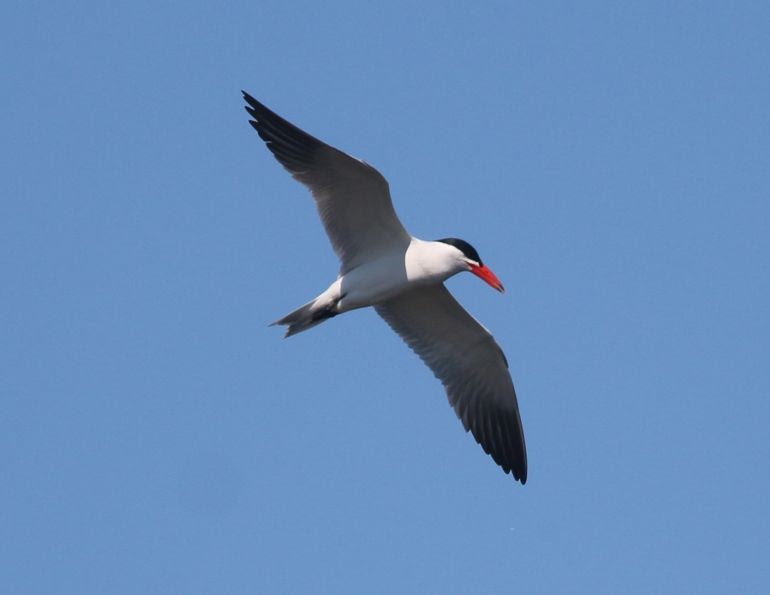
Caspian tern, Sømosen. Photo: Frank Desting
Tissø
West Zealand, 15km south-east of Kalundborg
Breeding avocets and little terns. Important staging area for geese and ducks and for wintering whooper swan and Bewick’s swan.
See Google map with look-out points, car parks, etc.

Tissø
Tissø is Denmark’s fourth largest lake (12.3km2) and has a relatively level bed with a depth of up to 14m. The lake lies in a so-called kettle-hole, created when the ice cap withdrew after the last ice age, isolating a huge lump of ice, which later melted. It is characterized by significant changes in water levels: the wide meadows and reedbeds are often water-logged in spring and dry out in summer. In late summer and in autumn the water-level is sometimes so low that sand and pebble banks are revealed. East of Tissø there are dry grassy slopes with interesting vegetation and a little wood with deciduous trees.
Breeding birds:
Tissø is especially interesting because it is a breeding site for avocet and little tern, which normally breed in coastal habitats. Both species nest together with common tern on the bird islands in the south-easterly part of the lake. Little gull has been observed here too in the past few years but it is not known whether they have been succesful in breeding.
Migrating and staging birds:
In winter, Tissø is an important staging area for waterbirds, and great crested grebe, gadwall, teal, mallard (often in large numbers), shoveler, pochard, tufted duck and goldeneye are seen. The lake and the surrounding fields are a very important winter locality for geese, especially bean goose, greylag goose and canada goose. White-fronted goose and barnacle goose are seen regularly but in smaller numbers. Mute swan, whooper swan and Bewick’s swan stage in fair numbers. Other staging birds include shelduck, smew, goosander and coot.
At least five pairs of white-tailed eagle nest in the vicinity and are often seen over the lake. Other raptors that are seen regularly include buzzard, red kite and peregrine. A few golden eagles have been seen along the eastern side of the lake. Large numbers of red kite have recently started to spend the winter around the lake and can often be seen going to roost east of the lake. 80 birds have been observed at one time.
The road connecting Svebølle in the north and Høng in the south passes the eastern end of Tissø. There is a bus to the lake from both Kalundborg and Slagelse.
There are good views of the lake from the public roads around it, but the lake and its banks are not accessible. There is a particularly good view of the lake from the road passing along its eastern end. To obtain a view over the south bank, one can turn off the above-mentioned road towards Hallenslev, opposite the church at Sæby. 300m along the road going west from the church is a car park with a bird sign. On the road after Hallenslev one passes the stream of Bøstrup Å. The birdlife on the meadows around the stream can be observed both from the road and from a car park next to the stream.

Little tern. Photo: Helge Sørensen
Tisvilde Hegn and Melby Overdrev
North Zealand
Old woodland and dry grasslands with many nesting birds
See Google map with car parks etc.
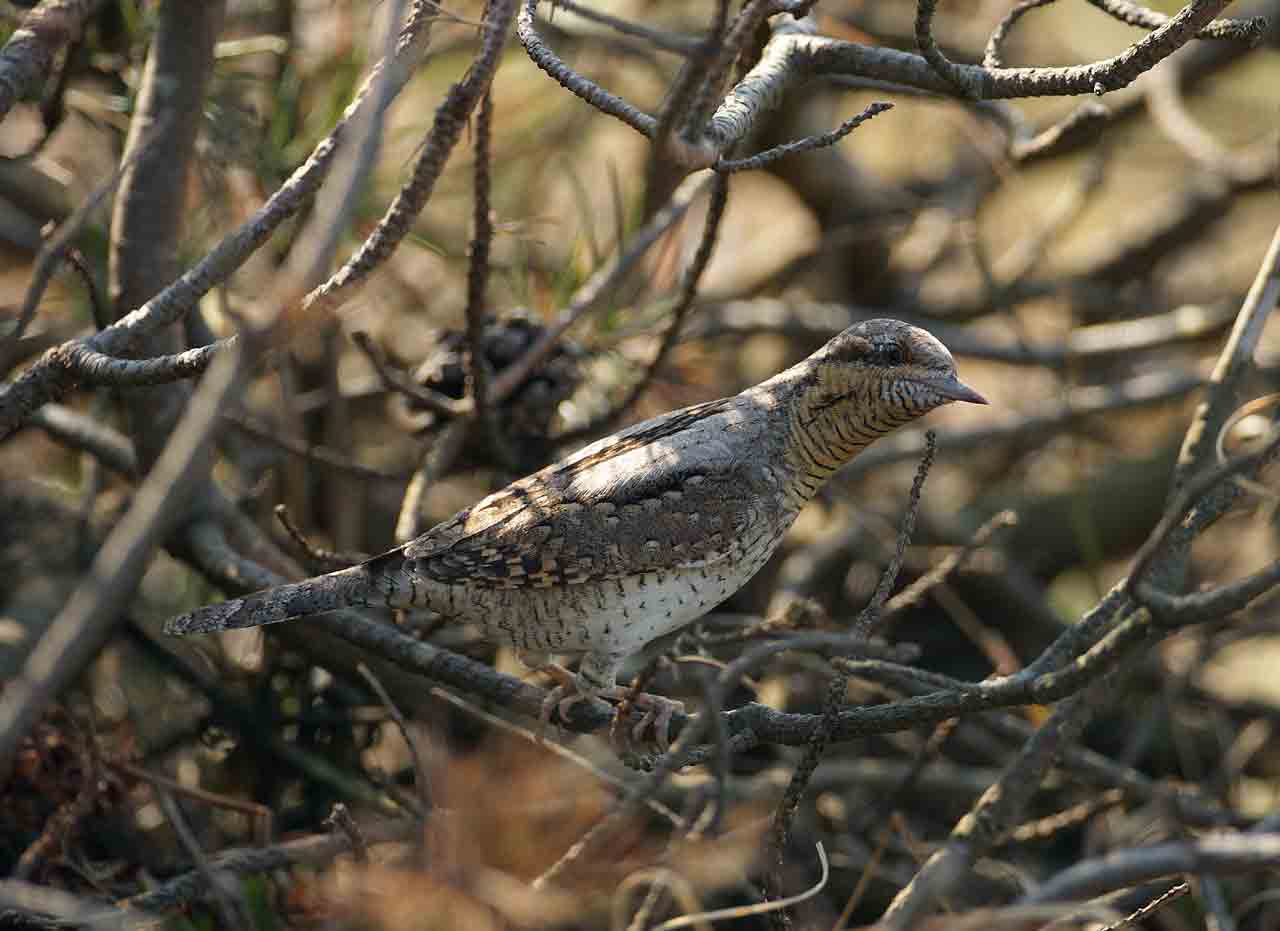
Wryneck. Photo: Axel Mortensen
Description:
Tisvilde Hegn lies north-east of Frederiksværk between the Arresø lake and the coast of northern Zealand. Together with Asserbo Plantage, Liseleje Plantage and Melby Overdrev, it stretches along 9km of the Kattegat coast. The woodland consists mainly of pine and spruce, planted to prevent shifting sands. Planting began around 1800. Dotted among the large stretches of conifers on the sandy soil are smaller patches of deciduous woodland, mainly oak and beech, which thrive on loose, soft earth. The trees are allowed to grow to a very great age and one can therefore see some magnificent old spruce and pine trees, whilst the woodland floor is very special with its covering of moss. Tisvilde Hegn is the woodland in Denmark that has the highest biodiversity score (at least 190 species). Unfortunately, mountain biking and orienteering activities have increased considerably in the past few years and these disturbances pose a threat to the breeding birds.
Between the plantations is the dry grassland of Melby Overdrev, which is Zealand’s largest heath, covering 145ha. It is dominated by grass and heather with a few scattered trees. The area is managed to prevent it becoming overgrown. It is home to many uncommon plants, butterflies and other insects, not counting the locally rare breeding bird species. Until a few years ago, the grassland was a military training ground, but is now open to the public and is a popular place for outings.
Birds:
Breeding birds:
Tilsvilde Hegn is a good locality for hole-nesting species thanks to the many old trees. It is therefore possible to spot stock dove, tawny owl, black woodpecker, great spotted woodpecker and lesser spotted woodpecker here. Other bird species are woodcock, long-eared owl and nightjar. All the common bird species can be found in the woodland and, in addition, rather more uncommon species such as woodlark, mistle thrush, wood warbler, short-toed treecreeper, red-backed shrike, redpoll, crossbill and hawfinch. Firecrest has become more common during the last few years. Several species of raptor nest in the woodland. Buzzard is the most common, but there are also honey buzzard, sparrowhawk and goshawk.
Melby Overdrev and the surrounding conifer forest house various species of bird which are otherwise uncommon on Zealand, for example nightjar, woodlark and stonechat. In addition, kestrel, whinchat and red-backed shrike nest on the grasslands.
In 2010 a little group of enthusiasts began putting wryneck nesting boxes up on Melby Overdrev with the aim to attract a small but regular breeding population in the area. The first wryneck bred in a nesting box in 2014 and since then there have been breeding birds almost every year - sometimes in boxes, sometimes in natural holes in tree stubs, old woodpecker holes and so on. In good years 2-3 pairs can nest here.
Migrating and staging birds:
From the end of June and up to the end of August/beginning of September, whimbrels - which are a rare autumn visitor to eastern Denmark - can be seen foraging on the heath, with crowberry being the dominant food. From October and up to February, Melby Overdrev is a staging post for golden plover which sometimes appear in large numbers.
In winter, it is often possible to spot twite and occasionally lapland bunting and shore lark on Melby Overdrev. Great grey shrike is a regular guest. Flocks of crossbills and smaller numbers of parrot crossbills fly across the open areas. From the coast bordering Tisvilde Hegn and Melby Overdrev one can look across the sea, where various diving ducks such as eider, common scoter and velvet scoter can be spotted, and now and again gannet, auks and several other seabirds. The rare american scoter has been seen every winter for the past five years off the coast at Melby Overdrev. In addition, slavonian grebe is spotted every winter.
Visiting and Access:
Tisvilde Hegn borders the coast north east of Frederiksværk. There are several routes by which one can reach the area. One possibility is to drive to the village of Tisvilde along route 267 from Helsinge. In the village, drive along Tisvildevej in the direction of Tisvildeleje. After about 3km the road ends in a large car park next to the beach. One can also take route 205 between Frederiksværk and Helsinge and turn north along Bisp Absalonsvej to the Slotsruinen (castle ruins) where there is a car park.
To get to Melby Overdrev, one can drive to Asserbo (between Frederiksværk and Liseleje) and turn east along Nyvej towards Helsinge. After 2km there is a car park on the left-hand side, from where a path leads through the wood and down to the beach. It is not allowed to drive a car along this road between 23.00h and 05.00h. At a roundabout around 1km further on, one can either drive straight ahead to a car park at the beach, or drive right to a car park at Stængehus. It is not allowed to park at the roadside. From the first car park it is easy to gain access to Melby Overdrev, where one can follow the roads and paths. The second car park is a good place to set out for Asserbo Plantage (to the south) or Tisvilde Hegn (to the north).
It is recommended to use the Nature Agency’s folder “Tisvilde Hegn” which shows the many paths and other facilities in the area – both Tisvilde Hegn and Melby Overdrev. It can be downloaded here.
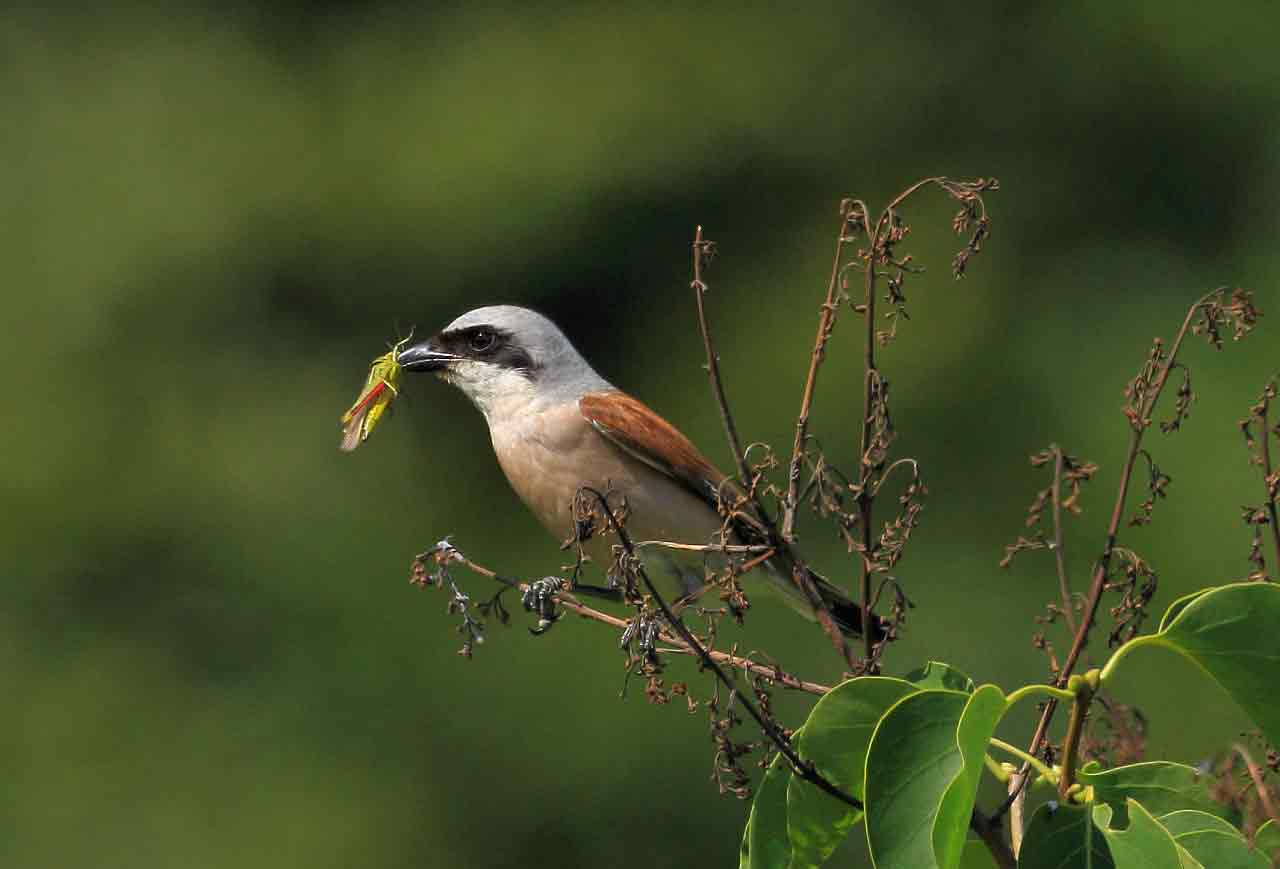
Red-backed shrike with large marsh grasshopper. Photo: Axel Mortensen
Tystrup-Bavelse Lakes
Mid-Zealand, south of Sorø and north-west of Næstved
The lakes and their surroundings are important wintering sites for large concentrations of geese and ducks, and are of international importance for tufted duck, bean goose and whooper swan. Many raptors winter here too, for example white-tailed eagle and golden eagle.
See Google map with look-out points, car parks, etc.
Guided bird tour to Hørhaven. Photo: Henrik Baark
Description:
In the middle of the Sorø-Slagelse-Næstved triangle is some of the most beautiful scenery in Zealand - Tystrup Sø and Bavelse Sø. The two lakes lie in a sub-glacial stream trench formed during the last ice age. The longest river on Zealand, the Suså, runs through the lakes. Tystrup Sø has a maximum depth of 23m, whilst Bavelse Sø is 8.8m deep. As the lakes are so deep, and as many springs rise from the lake beds, the water takes a long time to freeze over in winter. The openings in the ice benefit waterfowl.
In several places along the lake banks there are areas of shallow water, and in some places there are reedbeds. Midway along the lake system are some small, flat islets surrounded by reedbeds, called Vinstrup Holme. The lakes are surrounded by a hilly moraine landscape with arable land and woodland (Kellerød Skov, Frederikskilde Skov, Suserup Skov, Næsbyholm Storskov and Borup Ris/Gunderslevholm Dyrehave). Tystrup Sø is cut off from the much smaller Bavelse Sø by a tongue of land, Rejnstrup Holme, which to the north is traversed by a narrow channel where canoes pass in summer, resulting in disturbances to the birdlife.
Birds:
Breeding birds:
The woods, meadows and fields round the lakes offer a variety of birdlife all year round. The commoner passerines breed in the woods, which also house breeding raptors and owls. Suserup Skov is a wood with many hollow trees, which are ideal for nesting woodpeckers, nuthatch, stock dove and pied flycatcher. Along the lake banks there are nesting grebes, ducks and various reedbed birds, including marsh harrier. Various waders breed here, including oystercatcher and redshank.
Red-backed shrike nest in the area around Hørhaven amongst brambles, hawthorn and sloe bushes. Mallard, greylag goose and coot breed at Tamosen.
Red kite and raven have become more numerous and have established themselves in the nearby woodlands. White-tailed eagle has been breeding in the woods here for a good many years, with two to three youngsters fledging each year.
Migrating and staging birds:
The winter months, especially, offer a rich birdlife at the lakes. Many birds arrive from northern Scandinavia to stop off here: smew, goosander and whooper swan. Autumn and winter also see the arrival of large flocks of ducks: tufted duck predominate in number (up to 15,000) and there are also large flocks of mallard, as well as smaller populations of goldeneye, pochard and teal. At Tamosen, at the northern end of Tystrup Sø, both shelduck, shoveler, gadwall, wigeon, and now and again garganey can be seen.
Great grey shrike can often be spotted in the winter months sitting on the top of a bush or small tree.
Geese also arrive in winter. Bean geese dominate in numbers. Occasionally, pink-footed, white-fronted. canada and barnacle geese are observed. The geese fly to and from their night roost on the lakes, especially at Bavelse, or graze on the fields, chiefly at Gunderslevholm. Greylag geese are seen in the area all year round.
Passerines such as tits, finches, woodpeckers, treecreepers and crossbills can be found in the woods in the autumn and winter months. Kingfisher is observed throughout the year along the Suså and at Tamosen.
The lakes attract raptors such as buzzard, rough-legged buzzard, goshawk and hen harrier. There are good chances of seeing white-tailed eagle and golden eagle (the latter only in the winter months) from Hørhaven. It is not unusual to see osprey, marsh harrier, honey buzzard and peregrine.
Visiting and access:
Route A157 between Sorø and Skælskør passes the northern end of Tystrup Sø. There are several lay-bys and car parks around the lakes. Paths lead down to the lakes, especially on their northern sides. It is permitted to walk on the roads in the private woods, unless signs indicate the opposite. The woods can be closed due to hunting or forestry work.
1) At the northern end of Tystrup Sø is Kongskilde Nature Center. A little exhibition has been installed in the former mill farm. It is open all year round, but only during daytime. A yellow route from the carpark at the Nature Centre leads past the mill pond and the water mill. Continue along the path to the edge of Frederikskilde Skov and Tystrup Sø, from where one can perhaps catch a glimpse of an eagle. At the nearby lakeside at Frederikskilde Skov is a bathing beach with tables, benches and grill facilities, and to the north in the wood is a basic camp site for canoeists. There is also a large car park at the edge of the wood, from where the distance to the lake is shorter.
2) From the car park at the farm of Suserup (Suserupvej 14, opposite Sorø Golf Club), a marked path (yellow trail) leads to a bird hide with a view over the three peat bogs of Tamose. Swans, many species of ducks, raptors, waders, pigeons, owls, kingfishers, woodpeckers and many species of warblers are seen/heard here. The trail continues to where the Suså runs into Tystrup Sø. There are good views over Næsbyholm Storskov and Broby Vesterskov. There are tables and benches on the way. The area is grazed by cattle and wild ponies, which means that there are several gates to be passed. In some places this involves lifting some wires in the fence, which can be a little difficult.
3) Hørhaven on the western bank of Tystrup Sø can be reached by driving eastwards from the village of Vinstrup. There is a car park near the end of the gravel road, from where there is access to the hill of Bavnen (55m high), with fine views over both lakes and a chance to spot the large raptors. There is also a yellow trail in the area. At certain periods there are grazing cattle. At Hørhavegård there is a B&B with a café and a farm shop.
4) From the car park at the church at Bavelse, a path leads along Bavelse Sø (go round the back of the buildings) with views over the lake and the reedbeds at Rejnstrup Holme. The "Adgang forbudt" (No admission) sign at the farm applies only to the buildings and not the road along the lakeside. It is also possible to take a longer walk in Næsbyholm Storskov, which is an interesting and hilly landscape.
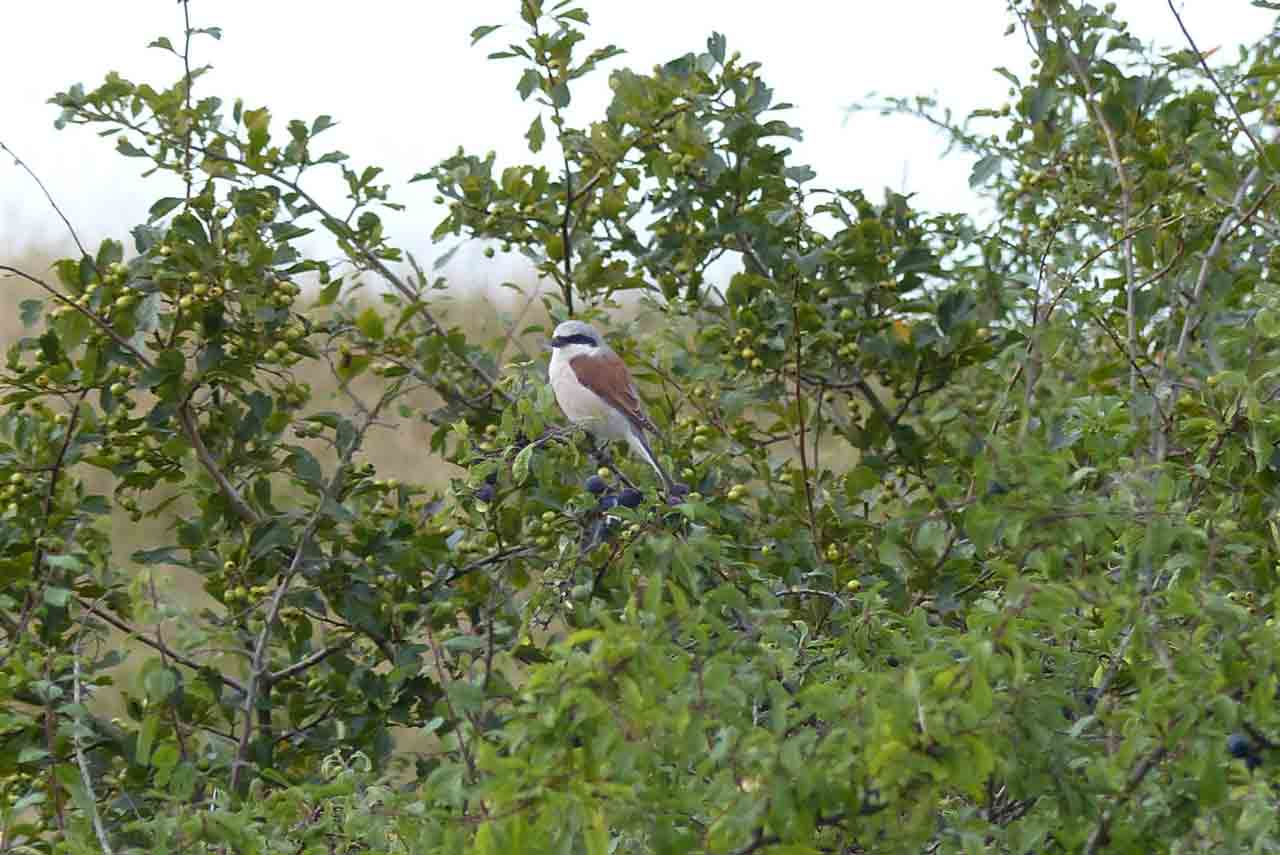
Red-backed shrike. Photo: Henrik Baark
Utterslev Mose
Copenhagen
Popular locality for bird-watching only 7km from the centre of Copenhagen. Semi-tame greylag geese and a large colony of black-headed gulls.
See Google map

Utterslev Mose. Photo: Joy Klein
Description:
Utterslev Mose is situated in the north-west area of outer Copenhagen between the suburbs Gladsaxe, Søborg, Bispebjerg and Brønshøj. Before Copenhagen became a big city, the area was a bog with large reedbeds. Today the bog comprises three lakes with some reedbed and several islets. Large lawns surround the lakes and give the area a park-like appearance. The water in the three lakes is very much polluted. In 1998 a “green sewage plant” was put into use in an attempt to improve water quality.
Birds:
Breeding birds:
The most characteristic birds of Utterslev Mose are the greylag geese. Although they are usually shy, they have become half tame here and can be seen close to. Some of them are even tame enough to be fed by hand. Many greylag geese spend the breeding season here, but the number of birds that actually breed has fallen the last few years. The best chance of seeing geese with goslings is at the western lake and the eastern lake. Previously, the goose families could be seen until August, when they again flew south, but in mild winters most of them stay on, and there can be around 300 birds here in the winter months, coming and going concurrently with periods of snow and ice.
Another characteristic bird here is the black-headed gull, which nests on the islets in the lakes. Many years ago the colony was the biggest in Europe with 20,000 pairs, but numbers have now dropped to around 1000 pairs.
Other breeding birds are great crested grebe, mute swan, mallard, coot, moorhen, tufted duck and in some years pochard. Gadwall have increased in numbers recently and are expected to breed here in the near future. Reed warbler and bearded tit nest in the reedbeds and blackcap, willow warbler, chiffchaff and short-toed treecreeper (3-5 pairs) in the park area. Thrush nightingale can be heard singing almost every year near the central lake. Buzzard and marsh harrier used to breed here, but have now stopped doing so. Kingfisher has often been seen during the breeding season, but there is probably no stable breeding population.
Migrating and staging birds:
Large areas of reedbed have recently been cleared from both the eastern and central lakes, so that in some years it is now possible to see several species of wader foraging here in spring, for example ruff, jack snipe, snipe, redshank and wood sandpiper as well as little ringed plover. Mediterranean gull, which nested in the gull colony in 2017 for the first and only time, can with luck be spotted from the observation tower in spring, staging here on migration. Bittern has been spotted in spring at both the western and central lakes, with up to three different individuals.
A relatively new species for Utterslev Mose is caspian tern, which breeds on Saltholm and flies for long distances when foraging. Normally, 1-3 birds can be spotted regularly from the end of July to the beginning of September, with a record number of 7 birds in 2014 seen fishing over the western lake in the first week in September.
Raptors can be seen passing overhead from the end of August until into October.
In winter, 1-2 white-tailed eagle can often be seen. They can sometimes be seen attacking coots near Teglholm and otherwise flying over all three lakes.
In winter, goosander, smew, mute swan, and occasionally whooper swan are seen. Many ducks winter here, including shoveler, goldeneye and tufted duck. Red-crested pochard can be seen very occasionally. Even in cold winters, the part of the lake adjacent to Grønnemose Allé is usually free of ice and there are good chances to get close to the many ducks and gulls that collect on the open water. Around 20 moorhen can be seen here. With luck one can spot a bittern in the reedbeds. In the park area in winter one can often see fieldfares, other thrushes and waxwings, and the last few years firecrest have been spotted by the eastern and central lakes, where they often forage in large bramble thickets.
Visiting and access:
Utterslev Mose can be reached by car from various directions and one can park on the surrounding roads and car parks. Several bus routes pass by the area: the 350S, 5C and 2A buses have a bus stop on Åkandevej (the western lake), and the 4A and 18 buses terminate at Emdrup Torv, from where there is a 500m walk along Grønnemose Allé to the eastern lake.
There are many paths on which one can walk or cycle all the way round the area. Several platforms have been erected on the banks of the lakes. At the south-western end is a large bird observation tower with a platform at the top and a lower floor with benches. From here, there is a panorama from west to north-east, and a view of the "gull island". There are public toilets near all three lakes: Åkandevej, Hareskovvej/Mosesvinget and Grønnemose Alle/the path at the eastern end.

Greylag geese. Photo: Helge Sørensen
Vaserne
Zealand, at the north-eastern corner of the lake of Furesø, west of Holte
In Vaserne there is a wide variety of birds
See Google map with bird observation tower etc.

Vaserne. Photo: Joy Klein
Description:
Vaserne is the name of a boggy area covering around 86ha at the north-east corner of the lake of Furesø. In 1999, 14ha of the area were handed over to the Bird Protection Foundation by Aage V. Jensens Fund. The area is dominated by reedbeds, alder bog, flooded peat pits, old deciduous woodland and meadows. The meadows are now grazed all year round by cattle and horses to improve conditions for waders. The alder bog has been left undisturbed for many years and now boasts many species. On the old alder stubs grow moss and fearns, and in the bog itself are many small animals, including water shrew, amphibeans and grass snakes. Various paths criss-cross the area and there is an exhibition pavillion and a bird observation tower with a view across the lake.
Birds:
Breeding birds:
Little grebe, red-necked grebe, coot, moorhen, several water rail and passerines such as bearded tit, reed warbler and reed bunting nest in the reedbeds. Most of the common forest birds breed in the scrub and in the deciduous woodland, together with some less common species such as green sandpiper, hawfinch, short-toed treecreeper and raven. The area is well known for its hole-nesting species that breed in the many hollow alder trees, for example great spotted woodpecker, redstart, nuthatch and - a special bird - the rare lesser spotted woodpecker. On the meadows there are nesting snipe and meadow pipit. In some years one can be lucky enough to hear the whiplashing calls of the spotted crake on the meadow - it was heard as recently as 2019. Kingfisher is seen throughout the year and breeds here some years.
Migrating and staging birds:
With luck, osprey can be spotted foraging over the bay or the old peat bogs in spring or early autumn. 1-2 white-tailed eagles are very often seen hunting at the lake known as "Olsens Sø", where their prey are the cormorants that breed in the colony there. Sparrowhawk and goshawk nest in the vicinity and are often seen. In winter especially, large flocks of ducks, particularly tufted duck, and also goosander and smew, can be seen from the observation tower. Blackbird, fieldfare and redwing can often be seen in October, when they form large flocks that feed on the berry bushes. In winter, many passerines can be seen in the woodland, including redpoll, siskin and brambling. Great grey shrike is a winter guest. Gadwall are seen regularly in autumn and winter.
Visiting and access:
From the S-train station at Holte there is about 1km to the edge of the Vaserne. Bus 334 from Holte station or Farum station also runs to Fyrrebakken at Vasevej. There is room for a few cars at the end of Fyrrebakken, or one can park at the roadside along Turistvej.
A new exhibition pavillion was opened in 2023. Here there are information posters, a bonfire site and seating. You can also find leaflets published by the Bird Protection Foundation. There are many paths criss-crossing the area. At the end of the Engstien path is a bird observation tower with a view across Store Kalv. The bottom platform is accessible to wheelchair users and prams by way of a long ramp leading from the path. A winding staircase leads up to the upper platform, which is covered and offers views in every direction. At "Olsens Sø" there is a bird hide which can be reached by a narrow bridge. Here there are also information boards about the birds and animals that can be seen here.
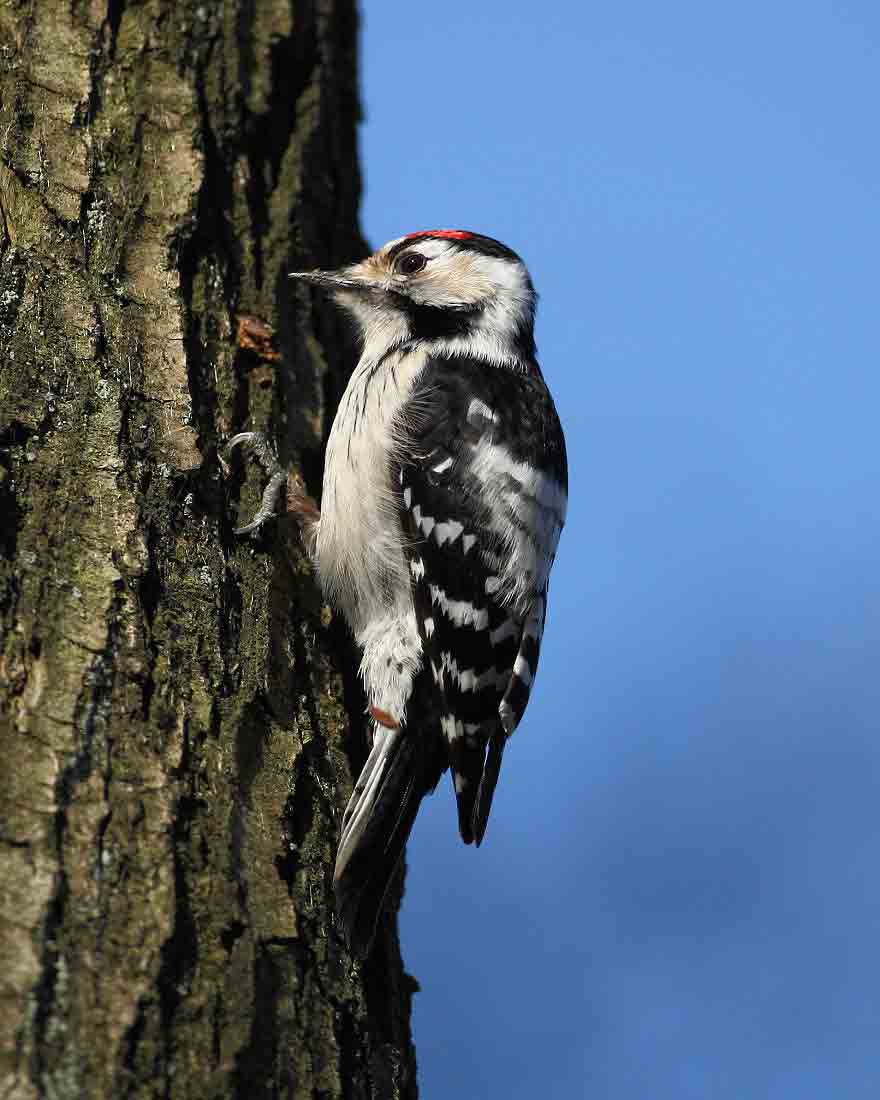
Lesser spotted woodpecker. Photo: Axel Mortensen
Vestamager
On the western side of Amager outside Copenhagen
One of eastern Denmark’s most important wetlands. Large populations of breeding and staging ducks and waders. Important staging ground for raptors.
See Google map with look-out points, bird observation towers, car parks, etc.

South-west Amager
Vestamager (or Kalvebod Fælled, as it is also called) was formed during the Second World War, when a huge embankment was built in the shallow waters off the west coast of Amager and the whole area was thereafter drained. The area covers 25km2, of which 22km2 are drained seabed. After the war and up to 1984 it was used as a military training area. The area is now a mosaic of grazed meadows, birch woods, willow scrub, ponds and wetlands. The whole of the south-west corner is an enclosed bird reserve called Klydesø (‘Avocet Lake’).
Between 2009 and 2012 the embankment was raised from 3.5m above sea level to 5.9m. Three bird observation towers were built on the embankment, giving a good view over various sections of Klydesø. At the same time, an artificial island was established in the lake. Another island was established in 2018.
Migrating and staging birds:
Many waterbirds stop over at the Klydesø during spring and autumn migration, including red-necked grebe, cormorant, mute swan, wigeon, gadwall, shoveler, mallard, teal, tufted duck, goldeneye and coot. On the meadows, flocks of greylag goose, golden plover and lapwing can be seen. Ever since Caspian terns started to breed on the island of Saltholm to the east in 2009, they have been seen daily at the Klydesø.
The Klydesø also attracts many migrating waders such as greenshank, wood sandpiper and alpina dunlin. In 2017 as many as 38 species of wader were spotted here, which – apart from the commoner species – included American golden plover, pectoral sandpiper, buff-breasted sandpiper, terek sandpiper and great snipe. Dotterel has started to turn up in autumn on a regular basis and has been seen nearly every year since 2012. Vestamager is one of the best sites in Denmark for broad-billed sandpiper. In both 2022 and 2023 there were over 30 birds on spring migration in May. Great snipe has been heard every year since 2014 at two favourite display sites. A long-billed dowitcher turned up in autumn 2023 and remained for 50 days. Red-necked phalarope stage regularly at the Klydesø.
Many passerines pass over the area in autumn, including thrushes, pipits and finches. The area attracts many raptors on autumn migration, especially osprey, hen harrier, buzzard, rough-legged buzzard and kestrel. Many other raptors can be seen in the area, including honey buzzard, red kite, marsh harrier, goshawk, sparrowhawk, merlin and peregrine. At the end of September/beginning of October one can be lucky enough to see hobby hunting dragonflies over the Hejresø and Pinseskoven - as many as ten have been seen at one time.
The Klydesø often houses unusual migratory guests. Apart from the waders already mentioned, little bittern, little egret, purple heron, glossy ibis, broad-billed sandpiper, lesser yellowlegs, gyr falcon, collared pratincole, Sabine’s gull and lesser grey shrike have also been seen. Great white egret has started to stage here throughout the year, either single birds or in small flocks. In September 2021, 43 great white egrets flew over the area and 24 of them were stationary for a short while. A total of eight species of heron have now been observed at Vestamager: bittern, little bittern, squacco heron, cattle egret, little egret, great white egret, grey heron and purple heron!
In winter, flocks of goosander and smew can often be seen in the Kalveboderne just outside the embankment. Around sunset, the birds fly from the Kalveboderne to roost in the Klydesø. Peregrine has been a regular daily guest in the winter months for quite a few years now. It can be seen sitting on a stone or a wooden post in the reserve. Some years, hen harriers have had a communal roosting site either in the reedbeds in the Klydesø or in the north-western section of the reserve, with as many as 17 birds. In the winter of 2022/23, a record number of 74 purple sandpipers were seen. They can be found on the outer side of the embankment between the south tower and the north tower. In winter snow buntings appear in small flocks.
Visiting and access:
Vestamager can be reached by the metro to Vestamager station. There are several bus routes along Kongelundsvej and Otto Baches Allé.
To reach Vestamager by car, leave Copenhagen centre by H.C. Andersens Boulevard, drive over the Langebro bridge and onto Amager Boulevard. From here, all the roads on the right-hand side lead to the Kalvebod Fælled. One can park at Kongelunden and then walk (about 20 minutes) or at one of the entrances at the side roads along Kongelundsvej: Finderupvej, Ugandavej, Hilversumvej and Frieslandsvej.
500m from the entrance at Finderupvej is a nature centre with a permanent exhibition, café and toilets.
There are six sites that are of particular interest for bird-watchers:
1) The Klydesø reserve is a good place for waterbirds and waders, but there is no public access. However, there are three bird observation towers on the embankment south and west of Klydesø. They can be reached from Kanalvej, which continues as Dæmningsvej along the embankment. The first tower is at the boundary of the reserve. The second tower gives a good view over part of the lake where there are many waders. The last tower offers a panorama of the meadows in the north-western part of the reserve.
2) Storehøj and Villahøj are good sites for observing migrating raptors, especially if the wind is coming from the north or north-west. In addition, a boardwalk system with two hides has been constructed in the reedbeds at Storehøj near the nature centre.
3) Birkedammen. Here, grebes, grey heron, mallard, tufted duck and many other birds can be observed. In the early summer, the reedbeds here are filled with the song of reed warblers.
4) Hejresø is a good place to see grebes, ducks and coot. In autumn, one can often see hobby hunting dragonflies over the lake.
5) Pinseskov is an unusual habitat in eastern Denmark, consisting of self-sown birch mixed with willow. The Nature Agency has also planted oak, ash and lime. Many passerines can be found in the wood, and in the early summer this is the place to hear thrush nightingales.
6) Kalvebodløbet is a narrow stretch of water between Amager and Zealand, just north of the Sjællandsbro bridge. In winter, this is a good place for ducks which congregate in thousands. Smew can be seen here in winter in large numbers.

Avocet. Photo: Albert Steen-Hansen
Ølsemagle Revle
East coast of Zealand, north of Køge
An important locality for staging waders in autumn.
See Google map with bird observation tower, car parks, etc.

Ølsemagle Revle is a 3km long sandbar that has been formed by material deposited by the sea in the calm, inner part of the bay of Køge Bugt. On the seaward side of the sandbar is a long sandy beach backed by dunes. A lagoon has formed between the sandbar and the coast. A storm in 2023 destroyed most of the dunes facing the sea, which will certainly cause more frequent flooding. The southern end of the sandbar became joined to the beach at Køge several years ago. As seawater can now only enter at the northern end of the sandbar, the water in the northern section of the lagoon is brackish, whilst there is fresh water in the southern section. This change has had negative consequences for waders, especially dunlins, but has been positive for dabbling ducks. Vegetation in the lagoon is gradually increasing, growth having been accelerated due to poor water flow and a considerable eutrophication due to pollution. On the landward side of the lagoon are coastal meadows, which are grazed. The meadows are often used by staging dabbling ducks and greylag geese, but support hardly any breeding birds. The sandbar was previously threatened by a massive influx of the invasive rugosa rose (Rosa rugosa) , but mechanical removal and grazing by sheep keeps the vegetation down. The beach is a popular place for bathing. Access is prohibited to the northern and southern tips of Ølsemagle Revle during the breeding season 1/4-15/7. This also includes the southern tip of Staunings Ø, north of the sandbar.
Breeding birds:
Due to the intensive recreational pressure put on the area it is difficult for coastal birds to find a quiet spot to breed, despite the restrictions for access duriing the breeding season. Breeding birds include little grebe, great crested grebe, mute swan, shelduck, mallard, water rail, coot, redshank, meadow pipit, yellow wagtail and bearded tit. The latter can be seen in the reedbeds all year round.
Migrating and staging birds:
The area is an important staging area for migrants, especially in autumn. Ølsemagle Revle is still one of the best staging areas in eastern Denmark for waders, and flocks can be seen resting or foraging in the area from July to well into November. Golden plover can be seen in their thousands and lapwing in their hundreds. In addition, all the common waders turn up, including oystercatcher, avocet, ringed plover, snipe, curlew, bar-tailed godwit, greenshank, redshank, knot, curlew sandpiper and little stint. A few individiuals of broad-billed sandpiper, Temminck's stint and red-necked phalarope can be seen in the period May to August. Little ringed plover can often be seen on the flats round the sandbar tips in late summer.
As the water in the lagoon has become more and more fresh, the numbers of dabbling ducks in autumn have increased and are now at a level which is remarkable for Zealand. Teal, wigeon and mallard turn up in hundreds, with pintail, gadwall and shoveler appearing in the flocks. A few garganey appear at the end of summer. In June, groups of female eiders can be seen in the lagoon together with their young. The area has become a very important staging and wintering locality for greylag geese, and sometimes barnacle geese, whilst brent geese are seen here on migration.
Ølsemagle Revle is also an important staging area and night roost for gulls and terns, of which the caspian tern in particular attracts bird-watchers. The caspian tern can mostly be spotted at the ends of the sandbar or along the embankment and can be seen from the end of April until September, with the highest numbers appearing in August, when up to a score of birds - most probably breeding birds from Saltholm and the south of Sweden - "tank up" before migration.
In autumn and winter, kingfisher is sometimes seen along the embankment, where it stays in the vicinity of some of the many channels that are often free of ice.
In winter, flocks of twite and snow bunting appear on the beach. White-tailed eagle is seen regularly, especially in the winter months. If the winter is mild, most species of dabbling duck can be found in the area together with flocks of tufted duck and goldeneye. It is usually possible to find some overwintering waders, too, including jack snipe in the more boggy areas. Long-tailed duck is often seen in Køge Bugt.
The best place to watch waders is at the northern end of the lagoon. It is worthwhile to check the islet with its sandflats and mudflats between Ølsemagle Revle and Staunings Ø. It is 2km out to the northern end of the lagoon. On the way, watch out for passerines on the sandbar, and ducks and seabirds out at sea. There is also a small sandspit at the southern end of the lagoon, but the birds are not so numerous.
From Staunings Ø there is a good view of the northernmost tip of Ølsemagle Revle and the birds that congregate around the outlet of the river (which is difficult to see from the sandbar). To reach Staunings Ø, one can park at Jersie Strandpark, on the eastern side of the most southerly roundabout in Solrød on Jersie Strandvej. From here, one can walk out to Staunings Ø.

Knots. Photo: Helge Sørensen



